Service history "Admiral Lazarev" - "Red Caucasus"
Launched on October 19 1913 at the factory "Russud". 18 March 1914 was enrolled in the Black Sea Fleet's vessel lists. 8 was launched on June 1916, construction stopped in November 1917. Completion of the new project began in September 1927.
March 9 The 1930 was completed by the Red Caucasus, which was being completed by order of the USSR Revolutionary Command No. 014 was included in the division (with the 1932 was the brigade) of the MSCM cruisers. Besides him, the brigade included the cruisers “Chervona Ukraine”, “Profin-turn” and “Comintern”. 25 January 1932. The cruiser entered service and entered the MSCM.
With the arrival in Sevastopol on the "Red Caucasus", the brigade commander Yu.F.Rall raised his flag, the brigade headquarters went to the ship.
On the night of 10 in May, 1932, while following the Chauda raid, collided with the cruiser “Profintern” while maneuvering, hitting him in the dungeon casemate and seriously damaged its bow. For repairs, he went to Nikolaev to the plant, repairs took 30 days. The commander of the ship, KG Meyer, was removed from his post; NF Zayats was appointed instead.
From 26 August to 6 September 1932, the “Red Caucasus” participated in the navigational voyage of the MSCM. Together with the battleship "Paris Commune" and the cruiser "Comintern" he made a trip to the Kerch Strait, Novorossiysk and Anapa.
In the years 1932-1934. the senior assistant to the commander of the "Red Caucasus" was N.G. Kuznetsov, who became in 1939 the People's Commissar of the Navy. Under him, techniques for the combat training of the crew were developed. As a result of hard daily study when summing up the results of combat training in the fall of 1933, the cruiser "Red Caucasus" took first place among the ships of the Black Sea fleet.
23 June 1933 The cruiser flying the flag of the submarine brigade commander WMSC G.V. Vasilyeva arrived in Batum, where 2 Italian submarines arrived with a visit. From October 17 to November 7 1933 of the “Red Caucasus” (commander N.F. Zayats) under the flag of the commander of the cruiser brigade Y.F. Rally with the destroyers “Petrovsky” and “Shaumyan” participated in the foreign campaign. The writers I.Ilf and E.Petrov took part in this cruise. October 17 ships left Sevastopol and the next day arrived in Istanbul. October 21 squad left the capital of Turkey and, after passing the Sea of Marmara and the Dardanelles, went to the Archipelago. On the morning of October 23, the ships embarked in the roads of Falé-ro, not far from the Greek port of Piraeus. Soviet sailors visited Piraeus and Athens. From October 30 to November 2, the squadron was on an official visit to Naples. A group of sailors on the Italian destroyer Saetta was brought to the island of Capri, where they met with AM Gorky. On the night of November 7, the squad returned to Sevastopol, having traveled 2600 miles.
12 November 1933 “Red Caucasus” with the destroyers “Petrovsky”, “Shaumyan” and “Frunze” came to Odessa, where the Soviet government delegation arrived on the steamer “Izmir” accompanied by cruisers “Profintern” and “Chervona Ukraine”. The cruiser inspected the Commissariat of Defense Kor Voroshilov and gave a high assessment to the combat skills of the crew.
In 1934, the "Red Caucasus" won the primacy of the Naval Forces of the USSR in all types of combat training.
Since January, 1935, the “Red Caucasus” is the flagship of the cruiser brigade and the only brigade wearing the pennant, the rest are in repair.
In the autumn of 1936, in connection with the civil war in Spain, the cruiser “Red Caucasus” was supposed to be sent, several destroyers and submarines to be sent to the Bay of Biscay for patrol service. The ships were in readiness, but the campaign was canceled. In the first days of March, the 1937 of the “Red Caucasus” and “Chervona Ukraine” under the command of the brigade commander I. S. Yumashev set out on a round trip along the Black Sea coast. The ships hit a heavy storm. The 4 of March in 4.30 the cruiser signalmen found the lights of the fake ball. The ship, changing course headed for ships in distress. They were fishing schooners "Petrovsky" and "Komsomolets". The cruiser managed to remove fishermen from them, after which the schooners sank. In the evening, at the Vorontsov lighthouse, the fishermen were transferred to a tug brought from Odessa. The 5 of March at 17.20, the Soviet ships disagreed with the Turkish battleship Yavuz Sultan Selim (formerly Geben), which was accompanied by three destroyers.
In 1937-1939 The cruiser was overhauled at Sevmorzavod.
22 June 1939. He joined the squadron of the Black Sea Fleet. In July, the Red Caucasus 1939 launched torpedo firing under the flag of the People's Commissar of the Navy, the flagship 2 of the rank of N.G. Kuznetsov.
14-18 June 1941. The cruiser participated in large all-fleet exercises in the north-western region of the Black Sea, conducted jointly with the troops of the Odessa Military District. The Red Caucasus covered the landing at Evpatoria with fire.
The Great Patriotic War "Red Caucasus" met under the command of the captain 2 of the rank of A.M. Guschina, being in the battle core of the fleet. In 16.00 22 June 1941 the order was received on the ship: to prepare for the setting of minefields, the cruiser ignition team went to the mine warehouse. 23 June in 11.20 to the side of the cruiser came the barge with 110 minami KB and began their loading ship arrows. In 13.25, the loading of mines was completed, two minutes later the ship was removed from the barrel and with the cruiser Chervona Ukraine, on which the cruiser brigade commander Captain 1 of rank SG Gorshkov was holding the flag out of the Main Base. In 16.20, the ships approached the staging area. In 17.06, at a speed of 12 ties, the “Red Caucasus” began staging, the first mine left the left ramp. Production Interval - 6 sec. In 17.17, the Red Caucasus completed the 109 mine (one mine went off the rails and, upon returning to the base, was put into storage) and in the 19.15 the cruisers returned to the base.
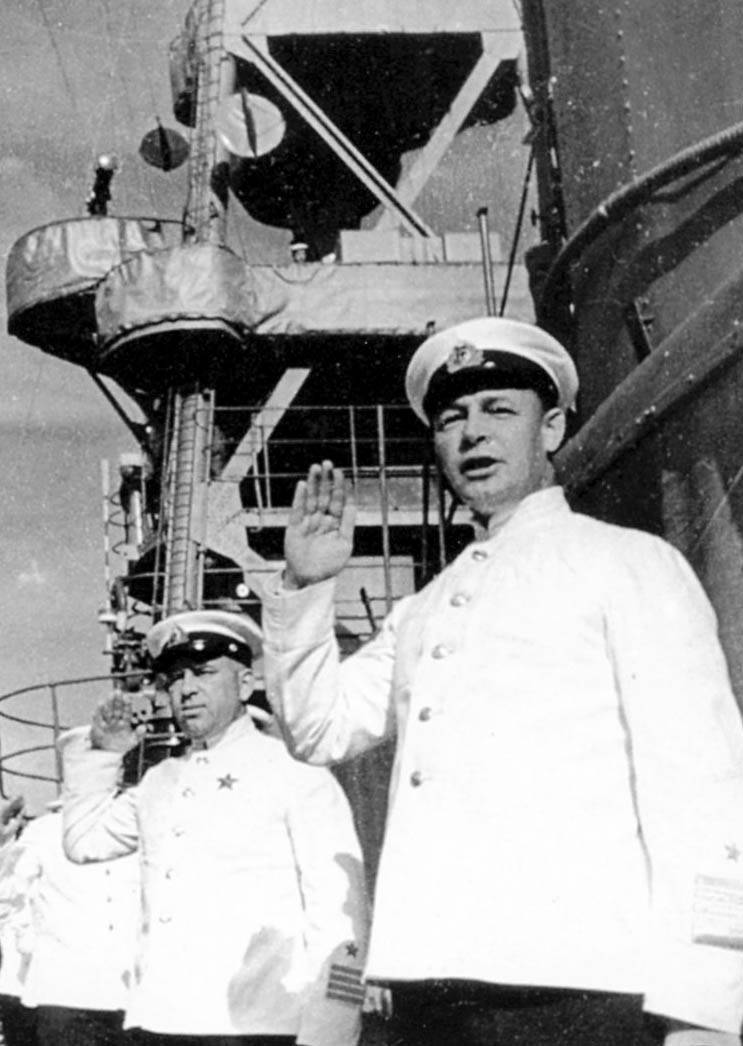
24 June "Red Caucasus" took 90 min arr. 1926 and in 8.40, together with the cruiser "Chervona Ukraine", went to the staging area. From 11.08 to 11.18 I put all the mines (speed 12 knot. 6 interval with), entered 11.38 in the wake of “Chervona Ukrainy” and the cruiser with the 18-nodal course went to the base. In 12.52, being on the Inkerman road, we saw a strong explosion on the right side of the nose in the boom area at a distance of 15-20 kb. The floating crane was blown up and sank, the tug SP-2 was damaged. Two minutes later, the cruiser stopped the course, and then gave a full back and began to turn to the left with machines, so as not to collide with the “Chervona Ukraine” that had stalled. In 13.06, a semaphore was received from the OVR commander: “Follow the base, keeping the Nordic edge of the Inkerman alignment”. The 13.37 cruiser was on the barrels.
The military council of the fleet decided to relocate the brigade of cruisers to Novorossiysk. 4 July, the ship took on board the equipment, weapons and 1200 people of the personnel of the torpedo school weapons and in 19.30 she withdrew. In 20.11, I passed the booms and took in tow two TCAs. Together with the “Red Caucasus” were the cruiser “Chervona Ukraine”, the destroyers “Sorazitelny”, “Capable” and “Intelligent”. July 5 at the approach to Novorossiysk TKA gave tugs and their course entered the base. On the fairway in the minefields of the ship passed with the set paravanami. In 9.20, the cruiser anchored in Novorossiysk the personnel and property of the school were unloaded onto barges.
10 September in 14.00 the commander of the "Red Caucasus" received the order of the chief of staff of the Black Sea Fleet to withdraw into Odessa at the disposal of the OOP commander Rear Admiral GV Zhukov to assist the defenders of the city. The order stated: “The total consumption of ammunition for coastal firing is set to 80 shells. Do not enter Odessa harbor, be in the area: the Great Fountain - Arcadia at slow speed ”. In 18.50, the cruiser was removed from the barrels, the output was provided by two SKA boats, I-153 and GTS aircraft, the speed at the junction - 18 knots. September 11 in 7.30 cruiser arrived in the area of the Big Fountain - Arcadia, fighter jets covered the ship from the air. In 10.00, a boat approached the side of the cruiser, on which the ship corps landed.
The maneuvering cruiser was attacked by enemy aircraft, four bombs fell 100 meters from the side. At 17.10, upon request from the shore, the cruiser fired at. Ilyinka, firing eight shells. In response, the enemy’s battery opened fire on the ship, its shells exploded 20 meters from the side, increasing speed, the cruiser left the affected area. At 18.50, having received data from the corps, he moved to the calculated point and fired at the enemy’s manpower and battery. After firing, at 20.00 he anchored. On the night of September 12, from 00.26 to 3.40, anchored from a distance of 145 kbt he was harassing fire in the village. Red migrant releasing 1 shell in 20 minutes (a total of 10 shells were used). At 4.34, the cruiser anchored and maneuvered around the Great Fountain - Arcadia. From 7.45 to 13.59, he opened fire three times on target designations of the corps. Twice aviation the enemy attacked the ship, but its anti-aircraft artillery opened intense fire and the planes turned away. At 17.32, RDO was received: “We worked successfully, thanks for the help. Commander 42 (42nd separate artillery division of the BO BSF). ” After 10 minutes, the boat delivered a corpse from the shore and the cruiser headed for Sevastopol. Already at sea, enemy aircraft attacked him, but anti-aircraft fire did not allow them to drop bombs on purpose. During the operation, the cruiser spent 85 180 mm, 159 100 mm and 189 45 mm shells and 1350 rounds of 12,7 mm and 7,62 mm. At 11.30 on September 13, the cruiser entered the Sevastopol Bay and stood on the barrels.
25 August front so close to Odessa, that the enemy began to fire at the city and port of long-range guns. September 9 commanded the fleet commander to prepare a landing force in Odessa, with the help of which to capture the enemy’s batteries. In Sevastopol, the 3 sea regiment was formed for this. However, his fighters and commanders had no experience of fighting on land and disembarking ships. Directive of the Black Sea Fleet of September 14 "Red Caucasus" was included in the squadron intended for the landing of troops at Grigorievka.
On September 14, the cruiser embarked on the Coal Wall to accept units of the 3 Marine Regiment and follow its training landing. 15 September the ship lifted aboard 10 barges; by 22.40 the 1000 landing force was sunk. The delay was due to the fact that one of the units, instead of coal, arrived at the commercial pier. 16 September in 00.49 "Red Caucasus" under the flag of the squadron commander Rear Admiral L. A. Vlady-Mirsky with the destroyers "Boky", "Impeccable", "Frunze" and "Dzerzhinsky" went to sea. In 2.10, not reaching 8 kbt to the Chersonesus lighthouse, anchored, dumped both ladders and, after launching barges, began landing, which continued until 3.20. It was complicated by a strong run-up, the right ladder was blown off by the barking strike, two people fell into the water, but were rescued. The loading of previously landed troops began at 4.10, which ended at 5.55. Lifting the barges aboard, the cruiser moved to the Cossack Bay, where, after anchorage, he landed troops ashore using floating craft. The 19.48 cruiser returned to the Sevastopol Bay and stood on the barrel.
On September 21, an order was received in 2.00: to anchor, to take a landing party in the Cossack Bay, to go to the Grigorievka area and, after artillery preparation, to disembark. In 6.13 the ship withdrew from the barrel and moved to the Cossack Bay. The landing began at 9.05, and half an hour later the cruiser finished receiving a battalion of marines - 696 soldiers and commanders, 8 mortars, ammunition and food. In 13.28, the ship under the flag of the landing commander S.Gorshkov left Cossack Bay and with the cruiser "Red Crimea" destroyers "Impeccable" and "Boky" headed for Odessa. From 18.57 to 19.30, two Non-111 made four attacks on ships, they were repelled by anti-aircraft fire, the ammunition consumption was: 56 100-mm and 40 45-mm projectiles. 22 September in 1.14 ships arrived at the rendezvous point with a detachment of landing craft, but he did not arrive from Odessa.
The cruiser anchored and began to descend the barges, and in 1.20 began the landing of paratroopers on four ramps on seven barges. "Red Crimea" and the destroyers opened fire on the shore, a fire broke out in the area of Grigorievka. During the landing of the assault troops in the aft cockpit, a grenade exploded, 16 people were injured. In 2.37, the “Red Caucasus” opened fire with the main caliber of villages. Sverdlovo. Rear Admiral L.Vladimirsky arrived at 3.20 on board. In 3.40, the landing ended, the barges were sent to the gunboat "Red Georgia" they were 27 people cruiser personnel. Supporting the landing, the cruiser used up: 8 180-mm, 42 100-mm, 10 45-mm projectiles. In the 4.05, the cruisers headed for Sevastopol, developing the speed of 24 knots. From the air the ships covered the fighters. In 16.33 22 September, the “Red Caucasus” began to barrel in the North Bay.
29 September The Supreme Command decided to evacuate the OOP and strengthen the defense of the Crimea at the expense of its troops.
3 October in 17.38 "Red Caucasus" withdrew from the barrel, went to sea and headed for Odessa. From the air, the ship was covered by the I-153 and Yak-1 fighters. In 5.55 4 in October, the cruiser anchored in Odessa’s outer roadstead. Having received the pilot, he withdrew from the anchor and headed for Novaya Harbor. For the first time, the cruiser entered the Odessa harbor, especially without tugboats. In 9.27, he moored to the New Mall, and in 15.55, the loading of evacuated troops and equipment began (they were loaded with ship arrows). Having taken 1750 people, 14 cars, 4 kitchens, the cruiser at 19.04 departed from the wall, set sail and headed for Sevastopol, where he arrived the next day at 10.30.
October 13 in 16.00 "Red Caucasus" withdrew from the Main base with the cruiser "Chervona Ukraine" (flag of L.А.Vladimirsky) and three destroyers. On October 14, he arrived in the area of Odessa and maneuvered in 30 KB from Vorontsov Lighthouse. The squadron commander forbade the cruisers to enter the harbor, as they lost their maneuver during attacks by enemy aircraft. A ship was landed on the ship. During the daytime, the cruiser in Odessa was repeatedly subjected to attacks by the bomber and torpedo aircraft of the enemy, but each time it fired antiaircraft artillery and maneuvered the aircraft to abandon attacks or drop bombs at sea. At night, the ship anchored in the outer roadstead. 14 of October, having received a target designation from the corps, in 21.30 from a distance of 178 KBT opened fire on the village. Shlyakovo. After the first shot in the third tower, the blowing system failed, as a result of which it did not shoot until the end of the operation. In addition, the main caliber firing scheme was repeatedly mismatched. In 22.25 shooting ended, 25 shells were fired. Time and expense show the unusual nature of the shooting - to influence the morale of the enemy, but not to defeat specific targets, which was a kind of military cunning during the period of withdrawal of troops. On October 15, the 6.10 cruiser was anchored and maneuvered before 20.00, repelling several attacks by torpedo bombers and bombers. In 20.06 received target designation from the corps and in 20.30 opened fire on the shore at enemy personnel. After releasing 27 main-caliber shells, 21.20 ceased firing. In 23.10, the cruiser anchored in 10 kbt from Vorontsov lighthouse and lowered three barges. On October 16, landing of troops began in 2.20, which were delivered from the shore by barges and tugs. In 5.35, an order was received by the squadron commander to "immediately anchor." By this time 1880 took a man instead of the alleged 2000 “Red Caucasus” on 6.00 with the cruiser “Chervona Ukraine” with the destroyers “Bodry”, “Intelligent”, “Shaumyan” headed for Sevastopol. In 11.00, having received the order of the squadron commander, the cruiser reversed the course and joined the guard of the Ukraine and Georgia and Chervona Ukraine transports under the flag of the squadron commander, increasing the speed to Sevastopol. At the junction, a Do-24 reconnaissance aircraft was detected five times, keeping its 125 kbt distance. With the 11.30 squad, the I-153 and LaGG-3 fighters covered up. In 23.19, the cruiser entered Sevastopol Bay and on the night of October 17, the troops brought from Odessa were unloaded.
October 20 the Nazi troops broke through to the Crimea, there was a threat to the main fleet base. Continuing to increase the number of troops in the area of Sevastopol, the Military Council of the fleet decided to hastily strengthen the air defense of a number of ports on the Caucasian coast suitable for basing ships.
October 23 on the "Red Caucasus" loaded 73-th anti-aircraft regiment - 12 anti-aircraft guns, 5 vehicles, 3 special vehicles, 5 quad machine guns, 2000 shells, 2000 people. The 21.45 cruiser withdrew from the barrel and left the Sevastopol Bay, the next at noon, arrived in Tuapse and anchored. The 16.15 moored to the wall and proceeded to unload.
On the morning of October 25, the cruiser arrived in Novorossiysk and anchored. In 13.40, barges of ammunition approached the board and were loaded by ship personnel. To 17.50, the ship received 15 wagons of ammunition, and in 19.56, she anchored and sailed into the sea, heading for the Main Base. October 26 on the approach to Sevastopol in the preservation of the cruiser entered two torpedo boats. In 11.17 he entered the Sevastopol Bay, stood on a barrel, gave a semaphore to the head of the fleet artillery department - “send a barge”. Only to 13.27 a barge approached the starboard side and the crew began unloading, which they finished at 16.24. For more than two hours, a ship with explosive cargo was on the roadstead, risking being attacked by enemy aircraft and taking off from the slightest fragment of a bomb.
On October 27, an order was received in 12.00: “Follow Tendrovskoy Spit, receive troops and property, exit to 15.00”.
The cruiser withdrew from the barrels and, accompanied by a boat MO and aviation in 15.08, left the Main Base. The 23.25 anchored in the region of Tendra, entering inside the bay. He lowered two barges that went to the shore. October 28 in 1.30 began accepting troops from barges, the schooner and the soldiers later approached. A total of 141 people were adopted, instead of the alleged 1000. The preparation of the troops for the evacuation was not carried out, the involvement of cruisers in such operations was impractical. In 3.17, the “Red Caucasus” was lifted from the anchor and headed for the 24-junction to Sevastopol. In 10.55, two I-153s appeared above the ship, and on the approach to the base, TKA entered security.
October 28 cruiser brigade was disbanded, the cruisers are directly subordinate to the squadron commander.
October 29 on the "Red Caucasus" plunged anti-aircraft battalion: 12 cannons, 12 vehicles 7 quad machine guns, 1600 shells, 1800 manpower. In 18.30 out of Sevastopol, accompanied by three MO. October 30 9.20 cruiser entered the Tuapse Bay, at the same time opened fire on two unidentified aircraft. The ship moored to the wall and began unloading, which ended in 11.30. Then he moved to Novorossiysk.
November 2 enemy aircraft made massive raids on the city, port and ships. Standing at anchor, the Red Caucasus during the day more than 10 opened fire on enemy planes, who turned away and could not precisely bomb the ship. On this day, the cruiser Voroshilov received serious damage, in which two bombs fell. In 17.00, the Red Caucasus received an order to tow the damaged Voroshilov, which two tugboats drove from the bay to the Doobsky lighthouse, where the Red Caucasus was to take it in tow. In 19.34, the ship began to anchor, but at that time a raid began, the non-111 planes dropped mines on parachutes into the fairway. In 21.15, the cruiser stepped on the raid and approached the damaged ship. From the "Red Caucasus" they straightened out the 200 of the six-inch towline, which was connected to the left anchor chain of the Voroshilov. In 00.20 3 November, the ships began to move at speeds of 3-4 knots. In the damaged cruiser, the steering wheel was jammed in the 8 ° position on the port side. When towing, it rolled to the left and the tug burst in the 1.42. In 2.56, the tug was filed a second time, the Voroshilov, while moving, worked part time on the machines, trying to stay in the wake of the Red Caucasus. In 6.00 passed minefields and lay on the general course. In 6.37, the commander of the OLS rear admiral T.A. Novikov who was on the damaged ship ordered an increase in speed to 12 knots, and after 10 minutes the destroyer "Intelligent" entered the guard of cruisers. In 7.38, the tugboat burst again, it took more than an hour to move the tug for the third time and the ships went at a speed of 6,2 ties. The 8.51 began the raid of enemy bombers, the cruiser repelled it with anti-aircraft fire. On the morning of November 4, the Voroshilov managed to put the steering wheel in the DP, the tug was given away, and the damaged cruiser went on its own, developing speed to 18 knots. In 13.03, the “Red Caucasus” was anchored on the Poti-raid. Reflecting the November 2-4 air strikes, cruiser anti-aircraft gunners fired 229 100-mm and 385 45-mm projectiles and about 5,5 thousand rounds.
On the same day, the cruiser moved to Tuapse. Refueling, the ship in 15.00 5 November went to Sevastopol, where he arrived the next day in 10.15.
On November 7, the cruiser moored at the Coal Wall and began loading the anti-aircraft regiment. On November 8, at 13.25, he moved away from the wall, anchored and continued to receive the servicemen and those evacuated from the boats. In total, the ship received: 23 anti-aircraft guns, 5 vehicles, 4 quad machine guns, 1550 military personnel, as well as 550 evacuees. At 17.53 the ship weighed anchor and headed to Novorossiysk with a 20-knot speed, where it arrived at 8.00 on November 9. At 8.20 the cruiser moored to the wall and unloading began with the help of two portal cranes. At 10.25 the unloading ended, and from 10.36 to 17.00 the cruiser was subjected to air raids five times. At 17.39, he departed from the wall to the roadstead, 500 people from the central institutions and employees of the fleet headquarters remained on the ship. At 18.04 "Krasny Kavkaz" weighed anchor to sail to Tuapse. At this time, a raid on the base began, a transport was blown up in the fairway by a magnetic mine. The Novorossiysk OVR banned the cruiser from going to sea. At 20.06, having received the go-ahead for the exit, "Krasny Kavkaz" weighed anchor and on November 10 at 3.36 anchored in Tuapse, and at 8.00:17.20 moored to the wall. Having finished unloading, he walked away from the wall, at XNUMX left Tuapse and headed for Sevastopol.
On November 11, at 3.00, the commander received a radiogram of the chief of staff of the Black Sea Fleet: “Enter the main base only at night, as the enemy is on m. Sarych ". All day, the cruiser maneuvered into the sea before dark and only on 3.18 on November 12 entered Sevastopol, anchored, and then moored to the Coal Wharf. On this day, the ships and the city were attacked by enemy aircraft by large forces (that day the cruiser Chervona Ukraine was sunk). On this day, the "Red Caucasus" 12 once attacked the bombers in groups of 2-3 aircraft, the 11.46 cruiser attacked 13 U-88. Only the intense and accurate anti-aircraft fire of the cruiser, forced the aircraft to collapse or drop bombs haphazardly. In 12.26, the ship began loading the troops of the 51 Army. In 16.21 during the next attack of enemy aircraft, the bombs fell in 30-70 m from the ship. When repelling attacks, 258 100-mm, 684 45-mm projectiles and more than 7,5 thousand 12,7- and 7,62-mm cartridges were spent. In 17.52, the ship finished loading, taking 1629 fighters and commanders, 7 guns, 17 vehicles, 5 quad machine guns, 400 shells, departed from the wall and anchored. Arrived on the cruiser, Chief of Staff of the Black Sea Fleet Rear Admiral I.D. Eliseev and the English representative Mr. Stades. In 20.49, the ship broke the anchor and left the main base. The headquarters of the 51 Army, who was on board the cruiser, awarded the award - 10 wristwatches for rewarding the personnel of the Red Caucasus anti-aircraft division.
On November 13, 5.00 received radio from a minesweeper in distress in the Yalta region. By order of the NS, the cruiser conducted a search, but since TSC did not disclose its coordinates, it was not found and lay down on the general course. In 17.40, a distress call was received from the tanker, but he did not answer calls and in 19.22 the search was stopped. 14 November in 5.19 "Red Caucasus" began to anchor on the outer roads of Tuapse, it was impossible to enter the port because of strong waves (wind 9 points, waves - 8 points). Only in the morning of November 15, the cruiser entered the Tuapse internal raid and anchored. Having stayed at anchor for more than a day, only on 8.45 16 in November the ship was able to finally moor to the pier and begin unloading troops from Sevastopol, and two hours after the end of the unloading, the troops began to load for Novorossiysk. Taking a 900 man, 19.50 came out of Tuapse. On November 17 in 2.06 moored in Novorossiysk to the Import pier and unloaded the delivered troops.
In the evening of December 1, 1941 was received an order from the fleet headquarters - to take troops and proceed to Sevastopol. By adopting 1000 man, 15 ammunition wagons and 10 canned wagons. December 2 in 3.25 cruiser went to sea, developing speed 20 bonds. In 18.53, he was met by the minesweeper TSH-16, who led him along the fairway. At 20.20, the ship moored to the Sevastopol Trade Pier and completed an unloading an hour later. Having received the task to fire at enemy positions in 1.20 3 of December, without departing from the wall, he opened fire with the main caliber of art. Suren, then at the intersection of roads north of Art. Suren and with. Tiberty. The 2.20 finished shooting. In 14.00 began loading equipment and troops. At the same time the ship was firing on s. Tiberti and Bakhchisarai. In 18.30 finished loading, taking 17 guns, 14 special vehicles, 6 cars, 4 kitchens, 750 Red Army and 350 evacuated. The 19.30 cruiser moved away from the wall. Following along the coast, the cruiser in 21.30-21.35 fired at a congestion of enemy troops in the region of Circass-Kerman,
launching 20 shells. Total December 3, "Red Caucasus" fired 135 180-mm projectiles according to enemy positions. 4 December he moored at the wall in Novorossiysk. December 5-6 cruiser moved from Novorossiysk to Poti.
7 December having taken 750 man and 12 guns, the 16.55 "Red Caucasus" moved away from the wall, and went out to sea in the guard of the destroyer "savvy". December 8 23.50 entered Sevastopol and anchored. On 2.15, December 9 moored at the Trade Quay and finished unloading before 4.00. Having received an order to deliver troops to Novorossiysk, the cruiser accepted the 1200 man, the 11 guns, the 4 cars. Fleet Commander Vice Admiral FS Oktyabrsky arrived at 15.45 (on orders from Moscow, he was heading to Novorossiysk to develop a plan for the landing operation). The Red Caucasus departed from the wall, the booms passed to 16.11, and the savvy destroyer entered protection. The weather was unfavorable: fog, visibility 2-3 kb, along fairway No. XXUMX in minefields passed by notation. In 2, December 10.00 arrived in Novorossiysk and anchored, and in 10 approached the pier, F.S. Oktyabrsky went ashore. Before 13.20, the ship has finished unloading.
The cruiser, among other ships, was supposed to participate in the landing operation on the Kerch Peninsula, but on December 17 the enemy launched a second offensive on Sevastopol along the entire front. Bid ordered to immediately deliver the replenishment of the defenders of the city.
20 December 16.00 fighters and commanders of the 1500 special rifle brigade, 79 mortar bombs, 8 vehicles were taken to the ship by 15, the flag of the fleet commander F.S. Oktyabrsky was raised on the ship. "Red Caucasus" departed from the wall and in 16.52 took to the sea at the head of the detachment: the cruiser "Red Crimea", the leader "Kharkov", the destroyers "Bouncy" and "Independent". On the approaches to Sevastopol, the weather deteriorated, the ships entered the fog strip. For this reason, as well as due to the absence of radio stations, the detachment was unable to enter the base at night. Proma nevrirovav for three hours behind the outer edge of the minefield, the detachment was forced to break through in the daytime. In 9.12 21 December “Kharkov” entered the head of the column, and in 10.45 the detachment entered the fairway No. 2, fighter jets patrolled over the ships. In 4, a detachment was attacked by German bombers, the ships opened anti-aircraft fire. In 12.17, the “Red Caucasus” moored to the warehouse pier of Sukharnaya Gully. The fleet commander went ashore. Within an hour the ship was attacked by enemy aircraft. Bombs fell around the cruiser and on the mountain of Sukharnaya gully. After dropping the troops, the cruiser received 13.05 wounded, departed from 500 and in 22.40 on December 00.05 left the base, this time the ship sailed without escort. From the district of Balaklava, the “Red Caucasus” fired on Belov’s dacha and sec. Chermez-Carmen. Then, along the fairway №22 passed minefields, and lay on the course 3 °. December 100 in 23 arrived in Tuapse and got up to the pier, where the wounded were unloaded into the sanitary train. During the operation, 20.46 39-mm, 180 45-mm, 100 78-mm projectiles and 45 thousand cartridges were used up.
He participated in the Kerch-Feodosia operation. At the first stage of the operation, was included in the detachment of the ship support for detachment "B" of Rear Admiral N. O. Abramov, who was supposed to land at Opuk.
The “Red Caucasus” with the destroyer “Deserter” had the task of 5.00 26 December to suppress the batteries, enemy firing points and support the troops landing from gunboats and escort boats in the area of the Duranda pier near Opuk with their artillery fire.
December 25 in 20.35 cruiser withdrew from the anchor and went to sea. Wind 7 points, excitement - 5 points. In the wake of the cruiser entered the destroyer "undeserving". December 26 in 4.30 going to the landing site, the cruiser decided on the fire U n-201. The weather in the landing area has improved, and the operation could well be realized. The cruiser went in the area with small passages, waiting for the arrival of gunboats and transports with the landing force. But neither at the appointed time, nor after dawn, not a single ship or boat arrived in the area of operation. The commander tried to communicate by radio with Rear Admiral N.O. Abramov or the Chief of Staff of the Black Sea Fleet about further actions, but the connection was not established. In 7.50, the cruiser Krasny Krym and two destroyers returned from the attack on Theodosia entered the wake of the Red Caucasus. At 9.00, the ship headed off to sea. The commander decided to go to Anapa with the expectation to meet the gunboats or to reach the landing party by radio. In 11.45 in 20-25 miles from Anapa, Kuban transport was encountered, unarmed. Assuming that the entire landing force is located at the landing point of the cruiser, without reaching Anapa, he turned on the course 315 °. The 14.05 found silhouettes of ships, they turned out to be minesweepers assigned to Rear-Admiral A. Frolov’s squad, operating from Kerch and returning to Anapa. In 14.31, torpedo bombers attacked, the ship opened fire, the torpedoes were dropped from a great height and passed at a great distance. During the hour continued raids single aircraft.
In 17.30, the “Red Caucasus” approached the landing area, did not find anyone, and before dark, maneuvered around the area to avoid collisions with other ships, included wake fire, and during turns, they were distinctive. In 19.10, he received by radio an order from the chief of staff to fire at the enemy’s shore near Opuk. From a distance 64 KBK 16 fired main-caliber shells. On 22.58 on 1,5 miles offshore, anchored and stood until dawn. The weather was extremely favorable for landing, but the landing craft did not appear. By December 6.00 27 it became known that the landing force had not left Anapa, the cruiser withdrew into the 7.02 anchor and entered the Novorossiysk bay in 13.43.
At the second stage of the operation "Red Caucasus" was included in the detachment of the ship support of the landing party "A". December 28 in Novorossiysk, he took 1586 fighters and commanders of the advanced detachment of the landing force, six 76-mm cannons, two mortars, 16 vehicles. The paratroopers were placed on the cockpit and on the upper deck. The 18.32 cruiser was withdrawn from the mooring lines, and at the head of the ship support and landing party detachment (2 cruisers, 3 destroyers, 2 BTs, 1 vehicles and 12 MO boats) went to sea. On the ship were the commander of the landing, captain 1 of the rank, N.Ye. Bassisty, and the commander of the ship support detachment, captain of 1, the rank of VAAndreev, officers of the landing headquarters. In the sea, the weather began to deteriorate, the boats flooded, and the detachment was forced to slow down from 18 to 14 knots.
December 29 in 2.30 ships arrived in the area of Feodosia. In 3.05, the ship support detachment was reorganized into a wake column and, having determined the fires of the previously deployed submarines Shch-201 and M-51, lay down on the fire tack in 3.45. In 3.48, the ships opened fire on the city and port. In 4.03, the fire was stopped, and the boats, with the first assault landing, began to break through to the port.
According to the disposition, the “Red Caucasus” was supposed to moor to the outer wall of the Wide mole on the left side, from the course. Under certain conditions, it was a winning option: the time of mooring was reduced and, consequently, the time spent under fire, losses were reduced. From the boat SKA-013, three Red Navy men were landed on the pier to receive mooring lines. But the wind began to change, he blew out from the shore. The 5.02 approached the outer wall of the Wide Pier, but the first attempt to bring the cruiser on the left side to the pier due to excessive caution of the commander failed. The mooring was interrupted by a strong pull-up wind of six points, the cruiser, having a large sail area, was blown to the right and it was impossible to move the mooring lines to the pier. The tugboat “Kabardian” was included in the detachment of the landing craft, which was supposed to provide the mooring of the cruiser. Following independently from Anapa, the Kabardian arrived at the approach point in a timely manner, but, seeing the firing of the ships along the coast and the enemy’s return fire, returned to Anapa.
Departing backwards from the pier, the captain of the 2 rank, A.M. Guschin, again sent the ship to the same place, but at a higher speed. A ship’s barge with a mooring cable, etched from a semi-lock, was sent to the pier. However, this attempt was unsuccessful, the wind pushed the ship away from the pier, and again failed mooring ends on the pier against the wind. This was due to the lack of experience of the commander in mooring to the pier at night in difficult conditions. The cruiser in the bases got up on the barrel or anchor, and moored to the pier with the help of tugs. The transports that arrived with the second echelon moored to the Wide jetty without any problems.
The enemy opened artillery-mortar fire on the cruiser. In 5.08, the first two mines exploded in the movie booth and casing of the turbofan. The fire started, the paint, the cinema booths and the bed nets burned. The first chimney was riddled with splinters. The fire in the nasal tube area was extinguished in seven minutes by two emergency batches and the personnel of the warhead-2.
In 5.17, the projectile hit the foremast right leg. From its rupture in the navigational felling area, paint, body kits, and cots were lighted up, with which a bridge was laid to protect it from bullets and shrapnel. The signalmen began to extinguish the fire, and then the 1-I emergency party arrived. Five minutes later, the fire was extinguished.
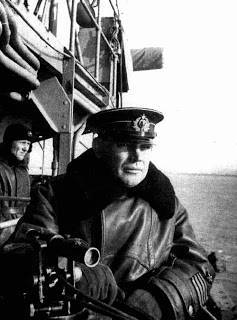
In 5.21, a six-inch shell pierced the side armor of the main caliber 2 turret and exploded in the fighting compartment. The majority of the command post was killed or was injured. A fire broke out in the tower - the electrical wiring and paint caught fire. In the elevator tray, the canisters were ignited with charges. There was a threat of fire spreading to the artillery cellar through the elevator loaded with ammunition. The 1 emergency combat post was sent to the aid of the gunners. The survivability battalion commander was ordered to inspect cellar No.2 and be ready to start irrigation and flooding. Smoke was coming from the tower, but the temperature in the artillery cellar remained normal. It was necessary to decide whether to flood the cellar or not. It was necessary at all costs to maintain the combat capability of the tower and to exclude the possibility of an explosion of the cellar. Despite the injury, the gunner of the tower VM Pokutny pulled a burning charge out of the elevator tray and rushed to the door of the tower, but received burns of the face and hands, lost consciousness and fell on a flaming charge. The artillery electrician P. I. Pilipko and the drill P. G. Pushkarev, who were busy mooring on the tank, saw that flames and smoke burst from the tower. P.Pilipko penetrated the tower through the manhole, then PGPushkarev, opening the tower door, together with P.IPilipko threw a burning charge onto the deck and carried out the wounded V.M. Pokut-ny, who were on the deck the sailors threw the charge overboard. The commander of the tower, Lieutenant IMGoilov, led the fire fighting campaign. After 9 minutes, the fire was liquidated, without resorting to flooding the cellar, and an hour later the tower was put into service, and the wounded soldiers were replaced.
In 5.35, two mines and a shell hit the signal bridge. The shell struck the right range finder and exploded overboard, a fire broke out on the bridge, paint, body kits, and spare signal flares burned. The fire unmasked the ship, but there was no one to extinguish it, since almost the entire personnel of the signal bridge failed. On the bridge, the flagship communications officer of the landing headquarters, Lieutenant Commander Ye.I. Vasiukov and Commander of the BCh-4 Lieutenant N.I.Denisov, died. Wounded by the military commissar of the cruiser GI Shcherbak and the head of the medical and sanitary department of the Navy brigade doctor FF Andreev. The first and second emergency posts were sent to eliminate the fire. Watering two hoses with water and using jackets and mattresses, the sailors for 2-3 minutes to eliminate the fire. In 5.45, the shell exploded in the ship’s workshop, making a hole in the board 350x300 mm at 1 m from the waterline. The shell broke a piece of 25-mm armor plate, damaged the 81 rail bulkhead, pipelines and cables with splinters. The hole was sealed with improvised materials (boards, mattresses, blankets), and the resulting fire was quickly extinguished.
After the second unsuccessful attempt to moor the ship with the left side, captain 1 of the rank of VA Andreev, in response to the commander's report on the impossibility of mooring with the left side, ordered to speed up the approach to the wall of the pier in any way. After 6 hours, the commander began a new mooring maneuver, this time with the starboard. The cruiser put the left anchor into the wind from the head of the Broad Pier and, after launching the barges into the water, began to wind up a mooring cable from the stern to the pier. A team of barcasses delivered it to the northern part of the Broad Pier and secured it on the quay. Then they began to choose a cable with a stern spire, pulling the stern to the pier. It was necessary to choose about 200 m cable. Meanwhile, the left ramp was dumped, and the landing of the paratroopers began with barges and then by small hunters who transported the 323 man. Simultaneously with the landing, the ship fired at the enemy firing points. With 100-mm gun fire, the gunners silenced the battery at city heights.
In 7.07, the projectile hit the port side in the area of the boiler room on 50 cp. and formed a hole the size of 1x0,5 m above the lower deck. This was followed by another hit, but the projectile did not penetrate 50-mm armor, but made a dent. After 10 minutes, the hole was sealed with a prefabricated shield, cork mattresses, cots and strengthened with stops. To the paratroopers who were in the cockpit, did not interfere with the work, the commander of the emergency department commanded them to "lie down". The filling of the holes was hampered by the air waves from the powder gases of the firing ship guns. Mattresses and cots flew out of the holes, and they had to be installed again several times.
At 7.15, the mooring was completed, the gangway was filed, and the paratroopers rushed ashore. But it was impossible to unload artillery and motor vehicles because of the cluttered berth. The enemy continued to fire the cruiser. In 7.17 between the upper and lower decks on 50 w. from the left side hit the shell. The blow fell at the junction of the sheets of armor and made a dent. In the boiler room №1 blow blew off the control panel. In 7.30 followed hit in the 66 area wn. between the forecastle deck and the upper deck. Two holes were formed with an area of 0,8x1,0 m and 1,0x1,5 m, in addition, a large number of fragmentation holes. Damaged transit pipes and highways. Holes filled up with materials at hand. 7.31 - falling into the conning tower. The projectile did not break through 125-mm armor, but splintered the grating bridge, the wheelhouse, the equipment was broken, the 2 bridge was destroyed, cabins on the bridges were destroyed. I interrupted the electrical wiring to the ship's control devices, damaged the instruments and the steering bollard. In 7.35, hitting the board in the Lenin cabin (42), at 0,5 m above the waterline, the water began to fill in the cabin, the hole was sealed with jackets, overcoats, mattresses, and supports.
In 7.39, three shells hit almost simultaneously on board between the lower and upper decks in the 44-54 area. 1x1,5 m and 0,5x0,5 m holes formed from the ruptures of two shells. The third projectile pierced the board without breaking, flew through the communal deck, hit the armored 25-mm communication cabin made a dent and exploded in the communal deck. The explosion destroyed two fans, damaged the electrical wiring, the opposite side was broken by shrapnel, the mine winding was broken at the length of 2,0. A fire broke out, which was quickly eliminated. In addition to these damages, fragments of the boarding, electrical cables, including the steering wheel electrical cable from the wheelhouse, transit lines, davits, booms, running rigging, etc., were pierced in many places with splinters.
In 8.08, the last paratrooper left the cruiser. In order to quickly move away from the pier, the anchor-chain was opened, the mooring lines were chopped off and in 8.15 the “Red Caucasus” left the zone of attack on the raid.
The remaining 16 vehicles on board, three 76-mm guns and ammunition in the period from 14.15 to 16.10 were loaded onto Azov transport.
From the Feodosiya raid, the ship continued with artillery fire to support the actions of the landing force. From 9.25 to 18.00 29 December ships were attacked by enemy aircraft. The cruiser "Red Caucasus" was attacked 14 times, but the attacks were unsuccessful, as the ship was prevented by target bombardment with anti-aircraft artillery fire and maneuver. From shaking, a single tube burst in boilers №1, 2, and 7. The tubes were plugged, the output of the boilers and the jamming took 2,5 hours. In 23.05, the cruiser anchored.
30 December in 7.15 "Red Caucasus" withdrew from the anchor and maneuvered in the readiness to open fire. From 11.51 to 12.30, according to the corpest, the ship was firing at der. Near Baybugs. In 14.15, the Azov transport, which arrived as part of the first squad of transports, approached the cruiser’s side. The 16 vehicles remaining on the cruiser, three guns and ammunition were loaded onto it. At the same time, the "Red Caucasus" was the slowest. During air raids, the overload ceased as the cruiser increased speed to evade bombs. In 16.10, the overload of vehicles for transport has ended. In 17.10, the ship re-opened fire on the enemy troop cluster. In 20.00, two non-111 torpedo bombers attacked the cruiser, but to no avail, the torpedoes passed astern.
In 1.30, the landing commander, N.E. Bassisty, with his headquarters, switched to the Savozhitelny destroyer, and the cruiser headed for Tuapse.
A total of 70 180-mm, 429 100-mm and 475 45-mm shells were consumed during the operation. Losses amounted to 27 killed and 66 injured. 12 shells hit the ship, 5 mines, 8 fires occurred.
Upon arrival in Tuapse, the cruiser was instructed to "follow to Novorossiysk." 2 January 1942 in 0.47 The Red Caucasus anchored in the Novorossiysk roadstead, because of the beginning of a storm, he could not enter the port. Only in the morning of January 3 the cruiser approached the pier and immediately received the order of Rear Admiral I.D. Eliseeva - take 224-th separate anti-aircraft division for delivery to Feodosia. 19.00 guns, 12 machine guns M-3, 4 kitchens, 2 trucks and one passenger car, 10 tractor, 2 boxes with shells and 1700 fighters and commanders were loaded onto the ship. After being loaded onto the ship, the 1200 Army Chief of Staff arrived with a headquarters, and the exit was delayed for 44 minutes. In 40, the cruiser departed from the wall, in 20.25 went beyond the minefields of the Novorossiysk naval base, and developed the speed of 23.44 bonds.
The peculiarity of the 3-4 January 1942 operation was that the cruiser already had damage from the previous 29 December 31-1941 G.: The 8 holes in the board that were patched with improvised means. In the conning tower, tachometers were out of order, in the wheelhouse - steering control devices.
The ship had only one anchor, the second was left on the ground during an emergency 29 December survey.
The fleet headquarters assumed that the cruiser would have time to enter the Feodosia port, unload and depart at a safe distance in the dark. But the command of the Novorossiysk naval base did not ensure the timely exit of the ship, and he lingered for 4 hours. It was also unacceptable that the cruiser went to the operation without anyone being guarded.
In the sea, the ship was met by wind 8 points, a wave - 5 points, air temperature - 17 ° С, water temperature + 1 ° С, visibility - one mile. 4 January in 6.15 "Red Caucasus" approached Theodosia Bay. At this point, due to the low air temperature, all cargo was frozen to the deck, the vehicles and tractors were frozen. The thickness of the ice reached 13, see. The personnel of the warhead-5 started to heat the motors of the machines with blowtorches, boiling water, steam. The 6.39 cruiser gave the right anchor, and after half an hour, moored the starboard to the wide jetty. The unloading began along three gangways: from the tank, the waist and the utah, the equipment was unloaded by the right boom. On the coast worked 80 Red Navy. For the movement of frozen tractors were used hoists, but after unloading to the shore, they did not start. With 8.30, the port was covered by the I-153 link. The unloading came to an end, two guns and several boxes of ammunition remained, but in 9.23 enemy air raids began, six Ju-87 attacked the cruiser from the coast from the starboard. Anti-aircraft guns opened fire on them. Aircraft, diving from three directions, dropped to 50 bombs. Bombs exploded at a distance 20-30 m from the side.
The 9.28 bomb slid across the board on the 120 cpr. and having made a dent, it exploded on the ground (depth 6,5 m). The explosion of the ship (stern) threw up and swayed to the port side. The blast wave caused great damage: there were holes in the casing below the armor belt, smashed the smoke equipment №2, its gases knocked out the stern emergency batch, blew off two 100-mm installations from the foundations (from the deck skewed at the moment of explosion). At the same time, a bomb that fell two meters from the port side destroyed the casing in two places. As a result, the large and small steering rooms flooded the steering compartment, the cellar of small artillery, the stern spire room, storerooms. Water began to flow into the diesel-dynamo room (the power plant was de-energized), cellars No.2, 3 and 4. There was a trim on the stern. A minute later was followed by an explosion in the 34 area wn. As a result, the lag mine's clinker crashed, the gyrocompass and the echo sounder were disabled, and water began to flow into the main navigator post. The bomb blast in the area 69-75 w. damaged the second-floor flooring and internal bulkheads, broke the foundation of the Worthington pump. Through the diverted seams in the 4-e boiler room, fuel oil mixed with water began to flow, fearing a fire, the boilers were taken out of action and the drainage pump was started. The joints of the seams of the trim on the mid-frame were separated. From shaking all the machines of the turbogenerators were knocked out, the lights went out. The elevators of the cellars No.1, 5, 7, rangefinders of fore-mars and the nasal bridge failed, the antennas of the Uragan transmitter were cut off, the central radio room was damaged.
By this time, two anti-aircraft guns, a passenger car, a kitchen, a small amount of ammunition were left on board. However, it was impossible to stay at the pier longer, in 9.32 they began to choose an anchor. Fearing that the stern and propellers would land on the ground (depth of the 7 position, m), the commander ordered the moorings to be cut down, gave the command “full speed ahead” to the car, and in 9.35 the ship moved away from the wall, the anchor was selected on the move. When steam was supplied, the right aft turbine “suffered”, which indicated damage to the propeller shaft or loss of the propeller, it was urgently stopped. The left stern turbine vibrated heavily. When giving steam, the right nasal did not move, and after it moved, it could not develop full turns (as it turned out, the cable was wound on its screw). The stern turbines were taken out of action, the cruiser was marching under two turbines, driven by machines, as the steering device failed. Fortunately, the rudders were in the center plane.
A survey of the ship’s premises, including light divers, showed that the main damage to the ship’s hull was caused by an explosion of an aerial bomb in the 124 area. from the starboard below the waterline. The divers found great damage in the hull trim in the area of the propellers. All the rooms in the aft compartment under the lower deck were flooded to 104. (storerooms, elektrostan-tion №13 and №14, large and small rudder rooms, executive motors, tiller, diesel, hairpin, propeller shaft corridors, artillery grate №4 and one third - cellar №3). On the lower deck along the current waterline (at 1 meters from the deck), the cabin of the commander, officers' cabin, and cabin are flooded. On the go ship upper deck to 125 w. immersed in water. Bulkheads 119 and 125 sk. deformed and pass water.
The ship received about 1700 tons of water in the feed area, losing up to 30% of its buoyancy. The displacement increased to 10 600 t, sediment nose 4,29 m, stern -9,68 m. Differential to the stern 5,39 m, roll to the right side 2,3 °, metacentric height 0,8 m at the rate of 1,1 m.
In good condition are 8 boilers, two nasal main machines. Large and small wheels do not work, telephone connection does not work. On the 2 ship, the wounded, 6 people were bruised, 7 were easily poisoned.
Coming out of the harbor, the "Red Caucasus" headed for Novorossiysk. The ship vibrated heavily, I had to slow down the speed of the turbines to 210 rpm. The cruiser went under two turbines, without steering on a magnetic compass. In 1,5 hours, a gyrocompass was commissioned. When departing from Theodosia, the cruiser was attacked by aircraft, but thanks to the maneuver and anti-aircraft fire there were no hits. When repelling aviation attacks, 94 100-mm and 177 45-mm shells were spent. In 10.20, in m. Ivan-Baba, the destroyer Able entered the cruiser’s escort, and communication with the command was carried out through it. The two remaining anti-aircraft guns on the deck were dropped overboard.
On the ship was a struggle for its vitality, which lasted all day and night. The main task was to prevent
water penetration beyond the watertight bulkhead on the 104 sp, behind which were the stern engine rooms. To straighten the ship from the stern bottom tanks to the released nasal tanks, 120 t of fuel oil and 80 t of coastal water were pumped over. To level the bank, they pumped fuel oil and removed some cargo from the right waist. With these measures, it was possible to reduce the trim by 1,7 m and align roll to 2 °. To reinforce decks, bulkheads, hatches and gaps, up to 20 wooden supports are installed. We managed to drain the fourth and partly the third cellar, repair cracks and rivet seams in the 4 boiler room and other premises. Divers managed to seal up many cracks in the tiller and diesel generator rooms with cement.
When approaching Novorossiysk, the cruiser commander requested the base to send tugs, since The cruiser could not pass independently through the difficult fairway. Instead of tugboats in 14.05, an order was received from the chief of staff to go to Tuapse. The weather deteriorated again, the wave to 4 points. The speed of the ship 6-7 bonds. 5 January in 5.50 "Red Caucasus" anchored in the roads of Tuapse. After 10 minutes, two tugboats approached and took the ship to the harbor, while the stern touched the ground. The cruiser moored to the import pier. In the compartments of the ship, about 1400 tons of water remained, displacement was about 10 100 t metacentric height - 0,76 m, trim aft 4,29 m (nose draft 4,35 m, stern - 8,64 m) roll - 3 °.
Upon arrival in Tuapse, the ASO divers inspected the cruiser and found that there were three large holes between the 114-133 and the right side, below the armor belt, three large holes, on the left side between the same frames - two. They were closed with a soft plaster. For a better fit, Plant No.201 made 2 wooden frames that tightly pressed adhesives.
Two motor pumps with a capacity of 400 t / h each were put on the ship’s deck, in addition, a tugboat SP-16 and a rescuer Shakhtar, having pumps with a total capacity of around 2000 t / h, stood at the side. Managed to drain the room on the lower deck and diesel generator. Started draining the small tiller-room. At the same time, holes were plugged, and individual water inlets were filled with cement. On the third day it was possible to drain this room. Sub-supported waterproof bulkheads on 114 and 119 cp. After all the measures taken to seal the holes and drain the compartments, 600 t of water was left uncharged. By January 20 rescue work was completed.
Simultaneously with the struggle for flooding, while staying in Tuapse, the second task was solved - finding an opportunity to fully restore the ship’s combat capability. As the diving inspection showed, it was necessary to carry out a complex repair of the hull in the underwater part, in the 114-136 area of the sp., Below the armor belt on both sides, and for this you need to be docked. Dry docks in which cruisers were usually repaired remained in Sevastopol. There were four floating docks, two of which were in Novorossiysk were out of order, and two in Poti had a load capacity of 5000 tons. The easiest way to dock the cruiser with a displacement of 8000 tons was to pair two docks, which were built for the rise of the cruiser Ave 26. But for mating docks, it was necessary to make and drive 4000 bolts and nuts, which required at least three months. At the same time there was no certainty that the ends of the dock towers would coincide, since the docks were from different pairs. In addition, for the installation of twin docks, it was necessary to double the pit. A more serious obstacle to the use of both docks in the repair of a cruiser was that the fleet would remain for a long time without docks for other ships. In addition, in the face of possible enemy air raids, it was unsafe to concentrate two docks and a cruiser in one place.
The flagship fleet engineer B.Ya. Krassikov proposed the option: use the float with a lifting capacity of 5000 t as a terminal caisson, which will allow repairing the damaged aft part of the cruiser. To do this, at the cutoff of the dock, in its opposite end on the slipway between the dock towers and the sides of the ship to put a transverse airtight bulkhead Calculations made by the Design Bureau of Plant No. XXUMX confirmed the reality of the proposal.
The ship was preparing to go to Poti. 17 machine tools were loaded onto the forecastle and needed to repair the ship and a lead cable reel of all around 200 t and took around 200 factory workers. The divers once again examined the underwater part of the ship.
On January 28, the cruiser stepped out of the boom, where he was taken in tow by the tanker Moscow. The sea was stormy, the roll was reaching 20-22 °. The stability of the ship was reduced by the presence of cargo on the forecastle, fuel oil, there was only 383 t, the lower compartments were almost empty. The presence of 600 t of water in semi-submerged rooms increased the roll. Ship dewatering facilities, as well as four portable hydraulic turbines and two ejectors operated continuously. At the junction tugging ropes were torn, vomited bollard. Then the cable for-sling the tower main caliber. On January 30, a cruiser was brought to Poti in 19.30, and two tugboats entered the harbor.
The preparation of the ship for the docking of the 5000 t was started. It was necessary to unload it, reducing the displacement from 8300 to 7320 t with the draft of 6,1 m. For this: in the 95-117 area. Four pontoons with a total lifting force of 300 t were installed, the steering compartment was finally drained, 150 t of filtration water was pumped out of the feed cellars, all liquid cargoes were removed: 30 t solar oil, 10 t turbine oil, boiler water - 50 t, watered fuel oil was pumped - 150 t , the 4-th barrel of the tower -30 t was taken off, storerooms of spare parts, etc. were unloaded. To reduce trim was flooded trim trim compartment on the 0-8 cp.
At the same time, the dock was being prepared to receive the damaged cruiser. The keel path in order to reduce the unit pressure in the aft and fore parts was gathered solid. Kilbloki dock further strengthened. They put six pairs of curved bottom cells and prepared 18 pairs of side supports for their installation in two rows in the area of the main transverse bulkheads of the cruiser. All this was done in order to ensure a stable position of the ship with the possible roll, trim and roll of the docking ship system.
All preparation was completed by March 24. The dock was dug-out and on March 26 the tugboat “Partizan” began to get the cruiser to the dock astern. The prow of the ship was supported by the tug SP-7.00. By 10, we finished the alignment of the ship according to its weight, began pumping water from the pontoons of the dock and lifting the dock on an even keel. After landing the cruiser on the cells and keel blocks, the dock suddenly began to roll to the starboard. Inspection showed that the ship was fault of the sailor of the dock, which had incorrectly stretched the glass wall, was shifted to the left on 10.00, see. The dock was again sank, the ship was centered. After the secondary lift of the dock, the stops were set under the aft valance and 80 pairs of side stops, two 13-ton pontoons were brought under the ship’s bow in the 80-15 area. The 25 finished docking ship trimming and then the divers, using the floating crane and hoists, began assembling the airlock bulkhead on the dock aft (on the ship hull 18.40). By 48 April, all work was completed, and 1 April, the damaged part of the hull was isolated from the intact on the lower deck. The cruiser's nose hung from the dock on the 4 m-the length of the 55 cruiser m and the dock's length was the 169,5 m. The docking-ship system was equal to 113 ° on the bow, and the roll - 3,2 / 1 ° to the starboard.
After the ship was docked, it was possible to find out the full amount of damage. The ship took through the holes 1695 t - 20,4% displacement with a loss of reserve buoyancy - 31%. In the 119125 area w. keel box and set concave inside the ship. Sheathing in the area is dented with an arrow dying to 600 mm and torn in two places. Akhtershteven, helmport small steering and keel box aft valance together with the heel are broken into pieces and pressed into the ship on 50 mm. The molded box-shaped part of the sintering bar in the area of the large steering wheel is interrupted at a distance of 0,8 meters from the heel. The connection of the molded part with the riveted box received a break, and the molded part sagged. Damaged keel on 114 sp. The trim to the 6 belt was molded on both sides. Damage are watertight bulkheads 114, 119, 125, 127 and 131 sp.
Four plates of the right-side armor belt are torn off and the bottom edge together with the hull plating is pressed inward. Two plates of the armor belt of the left side are torn off from the skin on 15-20 mm. Sheathing and kit in the area 119130 w. on the left side from the keel box to the lower edge of the armor plates are deformed. On the upper deck on the 109 and 118 wn. bulges formed with deflection up to 150 mm, riveted seams weakened. At the left side of the waist in the area of 63-75 w., Turned out to be a tear, in the area of 46, 50 and 75 w. there are cracks, and in the 49-50 area w. crack in the outer lining of the starboard side of the tank deck to the upper deck. Many double-bottom and on-board oil tanks passed water through the seams of the cladding. Butt seams of the 25-mm armor belt on the 55, 62, 93, 104 and 122-m frames of both sides were separated.
The lower arm of the propeller shaft of the bow of the right hand machine had a crack. The bracket, propeller shaft and screw of the right aft machine were repulsed completely along the flange of the deadwood and were lost at the parking place in Feodosia. The propeller shaft of the stern left-hand vehicle has cracks.
Of the auxiliary mechanisms, the steering device received the greatest damage. Torn from the iron brackets and bent manual drive small steering. The pinion gear is torn off along with the whole box, the shaft and the worm are bent. The buller of the stern spire was raised by an explosion upwards on 200 mm, the foundation is broken.
On the electrical part of the main damage were associated with the flooding of the compartments. Out of order: two executive electric motors and large steering transducers with stations, executive motors of a small steering and spire, main feed power station, diesel generators No.5 and No.6 and other mechanisms.
To restore the combat capability of the ship were performed difficult work. Akhtershteven and bushings of propeller shaft brackets were manufactured at the Red October Stalingrad plant. Damaged cast keel box on 119-130 w. was replaced by a new, welded design. We made a new riveted-welded heel of the stern hedge. On the corrugations of the outer skin and the crack of the keel box in the 114-115 area wp. put from keel to 3 belt from both sides patch sheets with thickness 10 mm. They reinforced with stiffening ribs the deformed hull casing, double bottom set and second flooring in the area of the 4 boiler room.
Replaced sheeting, deck flooring and platforms up to 600 m2. To this end, rivets were drilled and replaced with 4800, 7200 welded seams were welded. Straightened 1200 m frames and dialing. Installed new and partially repaired watertight bulkheads. Repaired the lower deck on 119-124 w. on the starboard side and longitudinal bulkheads on 119132 w. They removed, straightened and installed four armor plates on the starboard side and two - on the left.
From the reserve of the fleet used the propeller shaft, the propeller shaft brackets of the feeding machines. The crack in the leg of the propeller shaft bracket No. XXUMX was welded by electric welding. Deadwood pipes riveted and centered. Two damaged propellers were replaced, the screw of the right fore turbine was replaced with the one removed from the cruiser Chervona Ukraine. Conducted an audit and repair of the main and auxiliary mechanisms.
To speed up the exit of the ship from the dock, they decided to abandon the restoration of the small helm. A detailed study showed that the maneuverable elements of the ship in the presence of two or one rudders do not change significantly, and when the explosion, both rudders located nearby, still fail. Small steering wheel from the ship was removed.
216 workers were engaged in repairs, about 250 specialists were trained from the crew of the ship and distributed to production teams.
118 days continued intense, round-the-clock work in the unusual conditions of the cruiser in the dock. On July 22, the dock work was completed and two tugs brought the ship out of the dock. The rest of the work was completed afloat. During the repair, the ship’s anti-aircraft armament was significantly increased: two 100-mm Minizini systems installed from the cruiser Chervona Ukraine that had sunk in Sevastopol were additionally installed, two 76,2mm anti-aircraft guns were installed aft, two 34-mm guns and machine guns M-45, and mounted 4 8-mm machine guns 37-K, 70 DShK and 2 quad machine guns "Vikkers".
Thus, the recovery of the cruiser’s combat capability in difficult conditions was completed in 7,5 months, of which it was spent on preparatory work for about 2,5 months and for repair: 4 months - at the dock and month - after the dock.
By order of the People's Commissar of the Navy of 3 on April 1942, No. 72, the cruiser "Red Caucasus" was transformed into a Guards. On July 26, the squadron commander, counter-enemy L. A. Vladimir, solemnly presented the crew with a Guards flag, which was received by the ship's commander A. Gushchin.
15 July 1942 was the reorganization of the squadron of the Black Sea Fleet, the "Red Caucasus" became part of the newly formed brigade of the cruisers of the squadron of the Black Sea Fleet.
The 17-18 August cruiser, accompanied by the destroyer "Zaporozhnik" and SKR "Storm", was leaving Poti for sea trials, which showed good results.
In August 1942, the Nazi troops began to focus on the Tuap Sin direction. Tuapse was one of the three remaining bases of the Black Sea Fleet. For the defense of the city was created Tuapse defensive area. The ships of the fleet ensured the delivery of troops to Tuapse from Poti and Batumi.
September 11 "Red Caucasus", accompanied by the leader "Kharkov" and the destroyer "Soorazitelny" moved from Batumi to Poti, where he arrived in 8.45. The ships received the 145 th Marine Regiment and at 23.47 they brought it to Tuapse. 12 September with the destroyer "savvy" was back from Tuapse in Poti, then went to Batumi. On September 14 arrived in 7.35 from Batumi in Poti with the “Smart” and on 15.40 took on board the 668 th rifle regiment of the 408 th rifle division with weapons left Poti and 22.45 arrived in Tuapse. September 15 returned to Poti. September 16 with Smart was transported from Poti to Tuapse part of the 408 SD, and September 17 returned to Poti. September 28 in the escort of three SKA cruiser moved from Poti to Batumi.
19-20 of October “Red Caucasus” together with the leader “Kharkov” and the destroyer “Savvyoryny” delivered from Poti to Tuapse 3500 fighters and commanders, 24 guns and 40 and ammunition of the 10 th rifle brigade. Unloaded, the ships went to Batumi.
22 October 15.40 with the leader of "Kharkiv" and the destroyer "Merciless" came from Poti, carrying 3180 people, 11 guns, 18 mortars, 40 tons of ammunition and 20 tons of food 9-th Guards Rifle Brigade and 80 people and 5 guns 8 Guards Brigade. In 23.30 squad arrived in Tuapse. In 23.33, during mooring, ships were attacked by four TKAs, firing eight torpedoes that exploded on the shore. Ships not injured. October 23 ships moved from Tuapse to Batumi.
6 November 1942 AM Guschin received an appointment to the Main Naval Headquarters, captain 2 of rank VN Yeroshenko, former commander of the legendary leader Tashkent, took command of the cruiser.
In preparation for the landing in Southern Ozereyka, the fleet headquarters planned to use the battleship Paris Commune, but the directive of the Black Sea Fleet Commander from December 31 ordered to use the Red Caucasus instead. December 1942 cruiser with the leader "Kharkov" moved from Batumi to Poti, and on January 31 8 with the leader "Kharkov" and the destroyer "Sobrazitelny" returned to Batumi. In February, 1943, the ship was included in the squadron of cover ships: "Red Caucasus", the cruiser "Red Crimea", the leader "Kharkov", the destroyers "Merciless" and "savvy".
The cruiser "Red Caucasus", on which the commander of the cover detachment was holding the flag - the commander of the squadron L.Vladimirsky, in February 4.00 3 gave moorings and began to pull out of the base under the tugs. Coming to 5.21 for the boom, the cruiser immediately on the fairway found a standing vehicle that blocked the exit. I had to turn left to the shore and pass in narrowness. Approaching the edge of the minefield, the “Red Caucasus” stopped the cars, waiting for the “Red Crimea”, which was strongly delayed with the exit. 55 minutes he stood on the outer raid in the guard leader and destroyers. “Red Crimea” in 6.10 passed the bonds of the Batumi base and after 20 minutes entered the wake of the “Red Caucasus”.
In 6.30, all ships began to fall on the ship's channel No.2 (FVK 2), the head of the column went "Kharkov". At this very moment, the top range light turned off. In the minefields had to enter the bearing only on the lower leading fire, and only with the release of the detachment of the minefield, the upper fire was turned on. In 6.47, the detachment lined up for a marching order and, through 10 mines, lay down on the 295 ° course, with the expectation of moving westward, disorienting the enemy, and after darkness to follow the landing site.
From 8.40 to 17.00, the detachment was covered from the air, first with LaGG-3 fighters, then with Pe-2 dive bombers. In 12.30, on the left of 140 °, an aircraft (flying boat) "Gamburg-140" was discovered, which in 5 minutes was hidden
After that, no enemy aviation was detected, the February 3 sailing proceeded in a calm atmosphere. In 14 hours, the ships reduced the speed to a small one in order to arrive at the point of fire at a fixed time. In 18.05, the squad turned to 24 ° - in the area of operation. Before nightfall in 18.16 squad rebuilt, the leader stood in the wake of the cruisers, and the destroyers - in the head of the column.
In 22.55, a covering squad lay down on a course of 325 °, leading to a combat tack. In 00.12 48 minutes before the discovery of fire, a cipher telegram was received by the commander of the landing of Rear Admiral N.Ye.Basistoy from the destroyer “Zaporozhnik” with a request to postpone the shooting of cruisers for 1,5 hours in connection with the delay of tugboats with bolinders. Having received this encryption, L.Vladimirsky, without waiting for the decision of the comflot, decided to postpone the beginning of the artillery preparation to 2.30, about which he informed the comflot.
However, Vice-Admiral F.S. Oktyabrsky, who commanded the operation, received reports from the detachment commanders, ordered to act according to the approved plan and signed a radiogram in 0.30 addressed to N.YE.Basisty and L.Vladimirsky: “It’s too late everything is in motion ”, and then another telegram sent also to the commander of the fleet aviation and the commander of the Novorossiysk naval base, confirmed the start of the operation in February 1.00 4.
Thus, at the very beginning of the operation a situation arose that caused the inconsistency of the actions of the forces participating in it. The effect of surprise was lost. After the airstrike and the shelling of coastal artillery, the enemy could not only wait for the landing, but also determine the possible places of his landing. The cover detachment was supposed to begin processing the landing site after 15 min after the air strike, and in fact this happened after 1 h 45 min.
The covering detachment maneuvered with medium and full moves, at the rate of opening fire on 2.30. The forced change of courses and moves just before the shooting had a negative impact on the reliability of the gyrocompasses operation, as a result of which, when the approach was repeated, the ships had a less accurate place.
The delay in opening fire led to the fact that both cruisers were forced to shoot without adjusting the fire. According to the plan of operation, each ICC-2 was assigned to each cruiser and was duplicated by DB-Zf.
However, both DB-Zf did not fly to the area, the ICBM-2 of Captain Boychenko, attached to the Red Caucasus, also did not take off. “Red Crimea” established a stable connection with its aircraft in 23.40, but even before the shooting started, in 2.09 he went to the base, having spent fuel.
In 2.10, the cover detachment again approached the landing area, in the same order, and after 15 mines went to the 290 ° combat course, having 9 knots. In 2.31, at the signal of the flagship, the destroyer "Merciless" began firing lighting projectiles from a distance of 50 KB. From the very first volleys, he successfully illuminated the coast line in the landing area. Coast lighting continued until the end of the shooting of cruisers.
In 2.32, the “Red Caucasus” opened fire with a main caliber, and after 2 mines - 100-mm artillery. Then the treatment of the coast began "Red Crimea" and "Kharkov".
In the "Red Caucasus" in the fighting compartments of the main-caliber towers, during the shooting, a flame arrester was first used to release carbon monoxide (CO) despite the fact that the ventilation systems worked well. Carbon monoxide with spent cartridges was removed from the barrel and remained in the tower. The doors and hatches of the towers were opened, but after the 18-19 volley, personnel began to faint. Despite the poisoning, the personnel worked with the mechanisms until the last forces, trying to launch as many shells as possible. Initially, the departed commanders were replaced by sailors from the supply compartment, but they also fainted. The intensity of the main fire caliber began to fall, while 100-mm
In 2.50, reports of poisoning from the towers were received for medical aid posts. Medical orderlies and porters were sent to the towers, and people from the 34 wards were infected to the hospitals. Through the 5-6 watch all poisoned returned to service.
The 100-mm installations, when fired, had a total of 3 misfires. Ammunition 100-mm guns received as flameless, in fact, all turned out to be normal - ardent and strongly unmasked the ship. In general, the materiel of the ship's guns worked without serious damage and malfunction.
The situation during the shooting was complicated by the fact that ships with an assault force moved to the intersection of the course of the firing ships, and one of the gunboats dispersed with cruisers at a distance of several hundred meters. The approach of amphibious assault ships to the ships during the shelling of the shore could have unpredictable consequences: on the one hand, the possibility of attacking the torpedo
the enemy's pedal boats, which could have been mistaken for their landing craft, on the other hand, there was the likelihood that the ships of their landing craft would be destroyed by the fire of ships, which could be mistaken for the enemy's boats.
In 3.00, Red Caucasus ended up shooting, firing 75 (instead of 200) 180-mm and 299 100-mm projectiles. Having completed the shooting, the cruisers and the leader lay down on the course of departure, moving away from the coast to the rendezvous point with the destroyers. In 7.30 joined the "Merciless" and "Savvy" and entered into the preservation of cruisers. February 5 in 10.50 squad returned to Batumi, the cruiser later moved to Poti. 12 March in the protection of the destroyers "Boyky" and "Merciless" moved from Poti to Batumi.
In the operational directive from 28.05, Lieutenant-General I.Ye. Petrov, commander of the North Caucasus Front, ordered raiding operations in the Anapa and Blagoveshchenskoye areas to create an impression on the enemy about the active preparation of the fleet for the landing of the Taman group’s forces and divert some of its forces from Novorossiysk direction. In pursuance of the directive, the fleet commander ordered the squadron commander to make a demonstrative transition in daylight to Pitsunda and back. 4 June, at 12.04, the “Red Caucasus” under the flag of the squadron commander Vice-Admiral N.Ye.Basistoy with the leader “Kharkiv”, the destroyers “Able”, “Sozyrazhitelny”, “Boky” left Batumi for the Pitsunda-Sochi area to demonstrate landing troops. In 16.30 and 17.58, the ships were discovered by an air reconnaissance aircraft, and then sharply turned to the south-west, demonstrating the desire to hide the true direction of movement from intelligence, and then turned north-east to the previous course. In 20.05, the ships gave a radiogram to convince the enemy to move the detachment to the north, and at nightfall they began to retreat to Batumi, where they arrived in 6.40 on June 5. The campaign did not reach the goal, the enemy did not attach much importance to it.
23 June 1943 with the destroyers "Merciless", "Smart", "Capable" moved to Batumi - Poti, and on July 31 returned to Batumi.
15 July 1944 in the protection of the destroyers "savvy", "vigorous", "undeclared", "Zheleznyakov" moved from Batumi to Poti. In the fall he got up for repair. 23 May 1945 arrived in Sevastopol. At the Victory Parade 24 June 1945, the guards flag of the cruiser “Red Caucasus” was carried in front of the consolidated battalion of Black Sea sailors.
In 1946, the docking and emergency work took place. The ship was recognized as inferior, it was believed that he could remain in the ranks for some time without a major overhaul, which was deemed inexpedient.
May 12 The 1947 cruiser was withdrawn from service and reclassified to a training cruiser. In the fall of 1952, it was disarmed, turned into a target, 21 on November 1952 was sunk in the Feodosiya area by a Tu-4 plane when tested by an anti-ship cruise missile KF and 3 in January 1953 was excluded from the Navy lists.
October 22 1967 The cruiser’s flag of the cruiser was hoisted on the large anti-submarine ship of the Red Caucasus 61 Ave.
- Alexander Chernyshev, chapters of the book "Stalin's Guards Cruisers"
- "Svetlana". History of creation
Service history "Svetlana"
Service history "Admiral Nakhimov" - "Chervona Ukraine"
Service history "Admiral Lazarev" - "Red Caucasus"
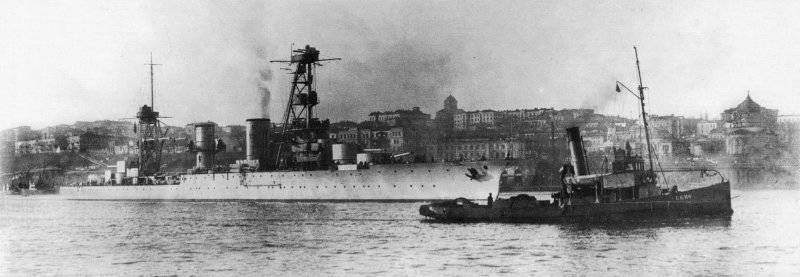
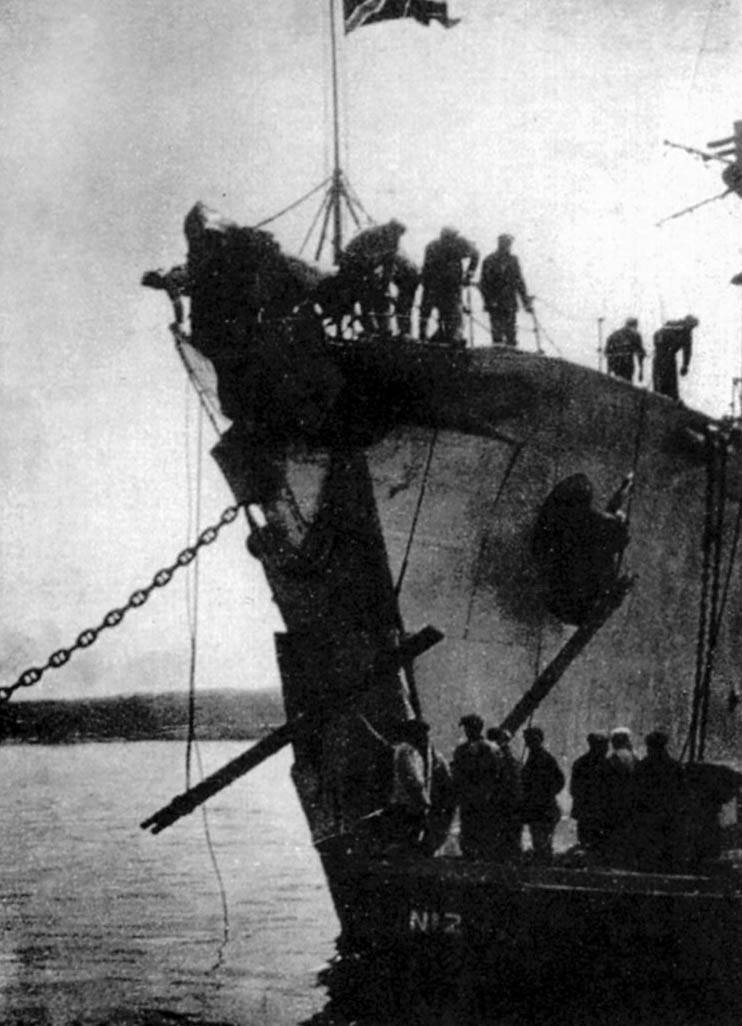
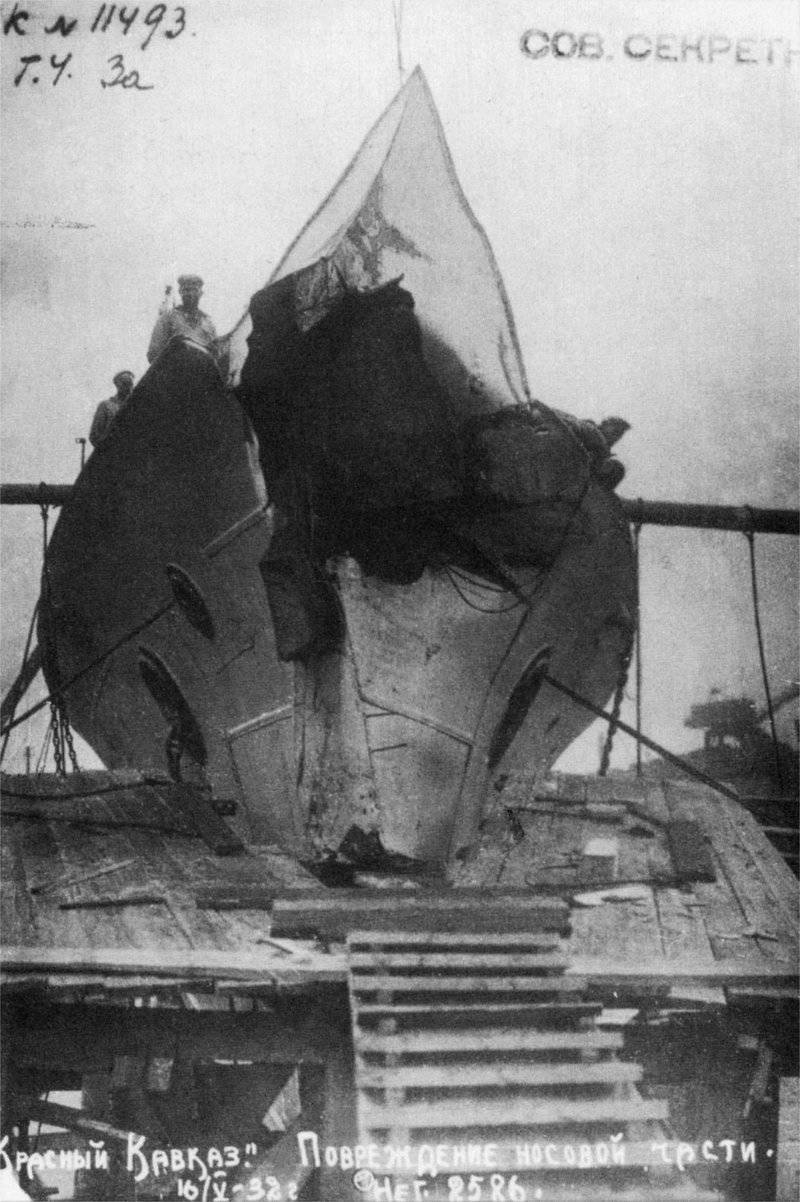
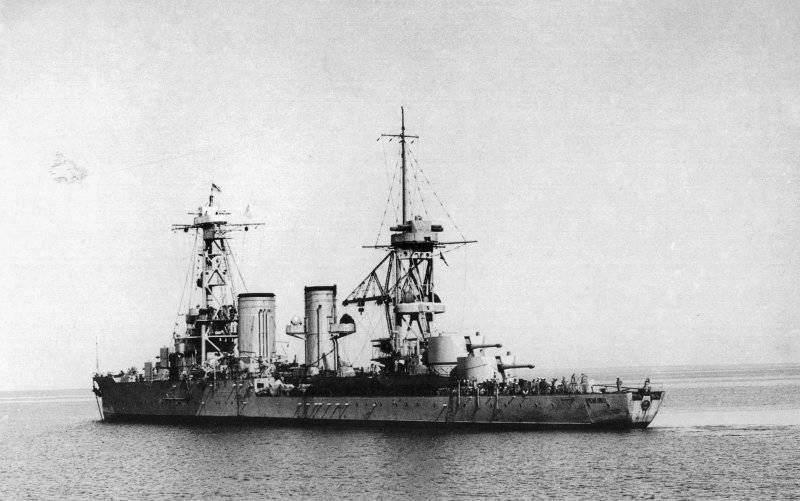
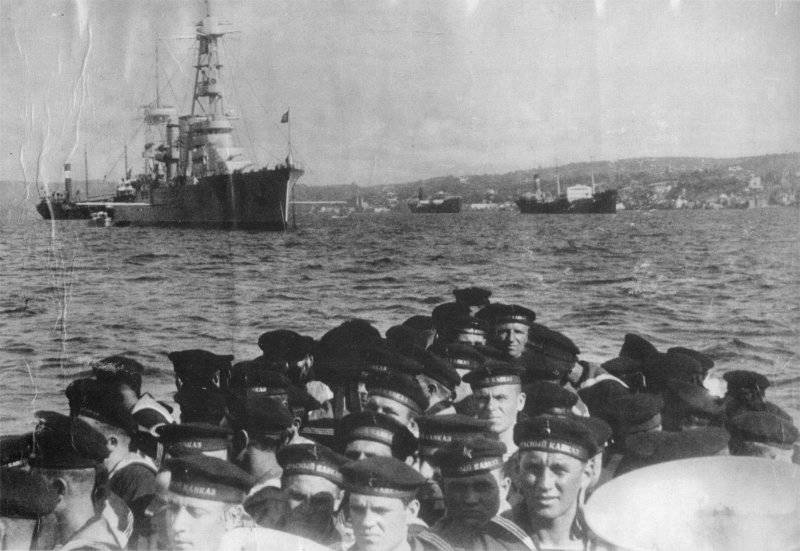
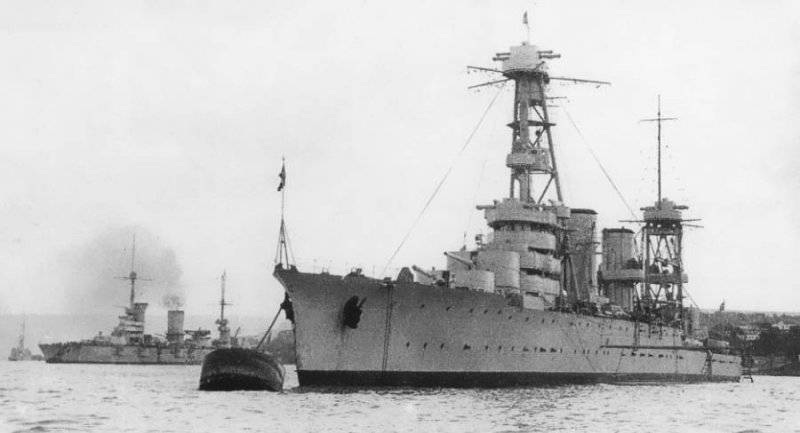
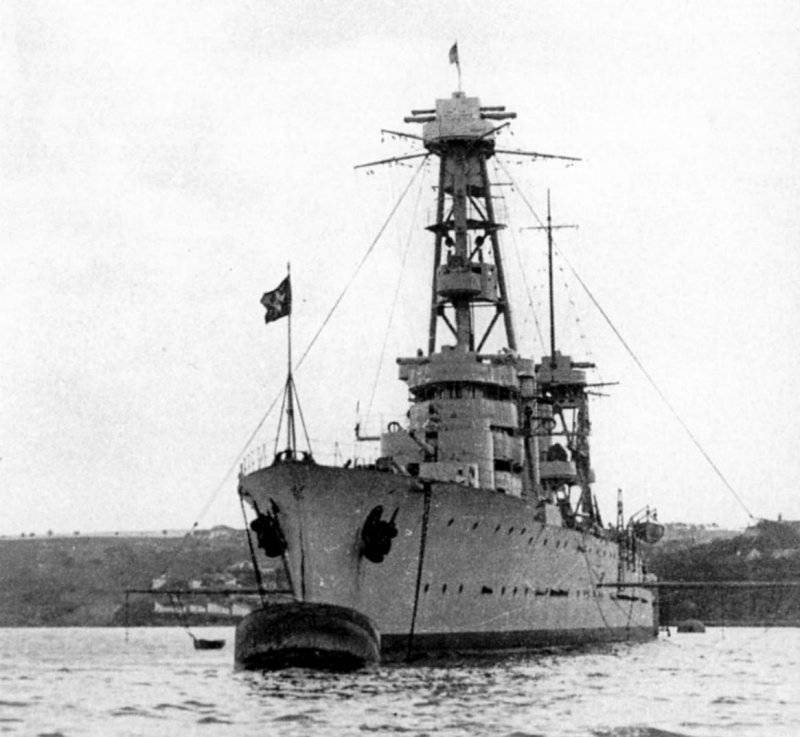
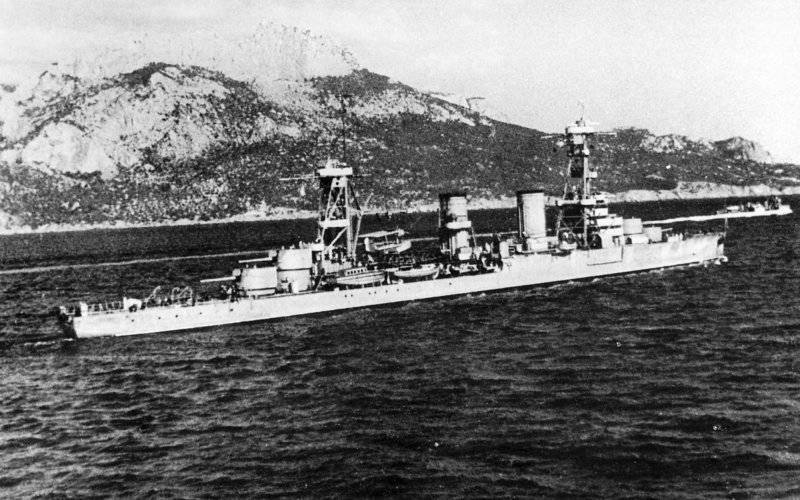
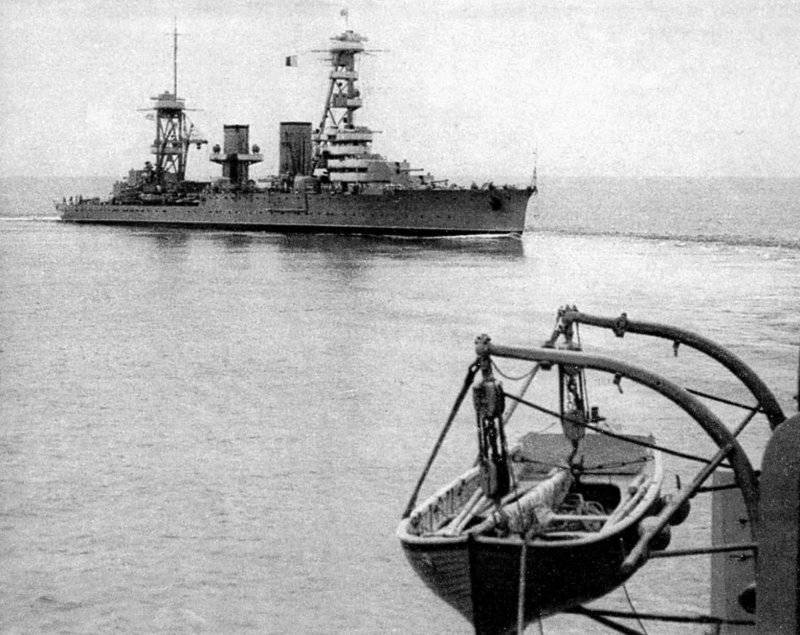
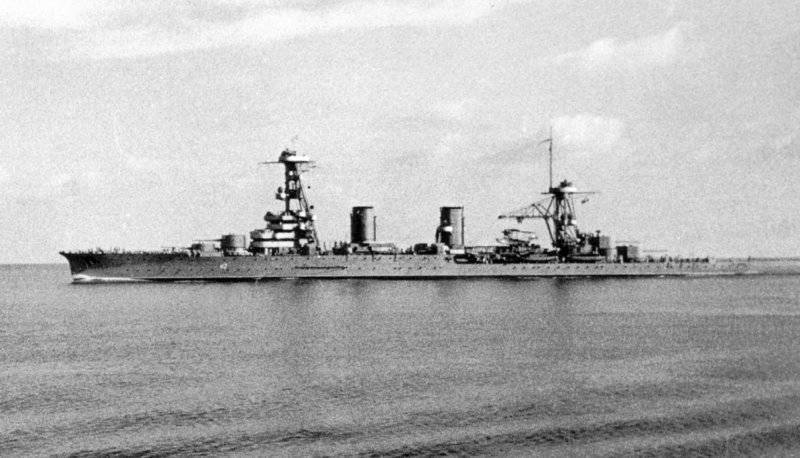
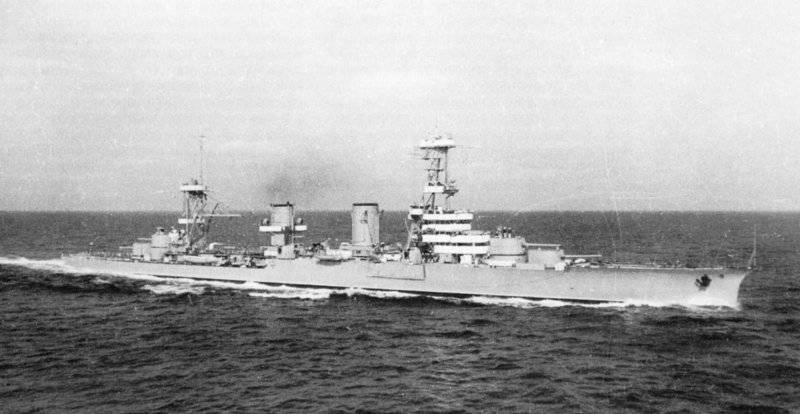
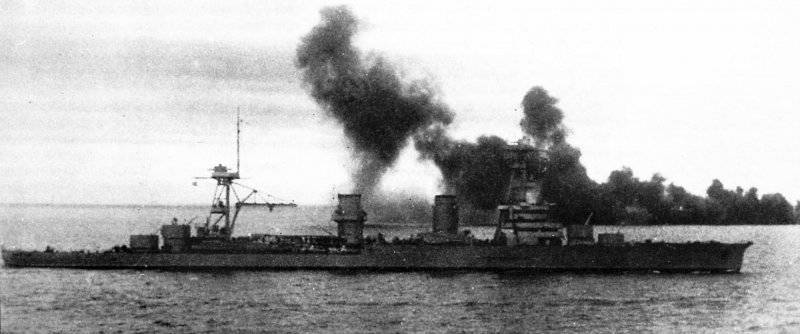
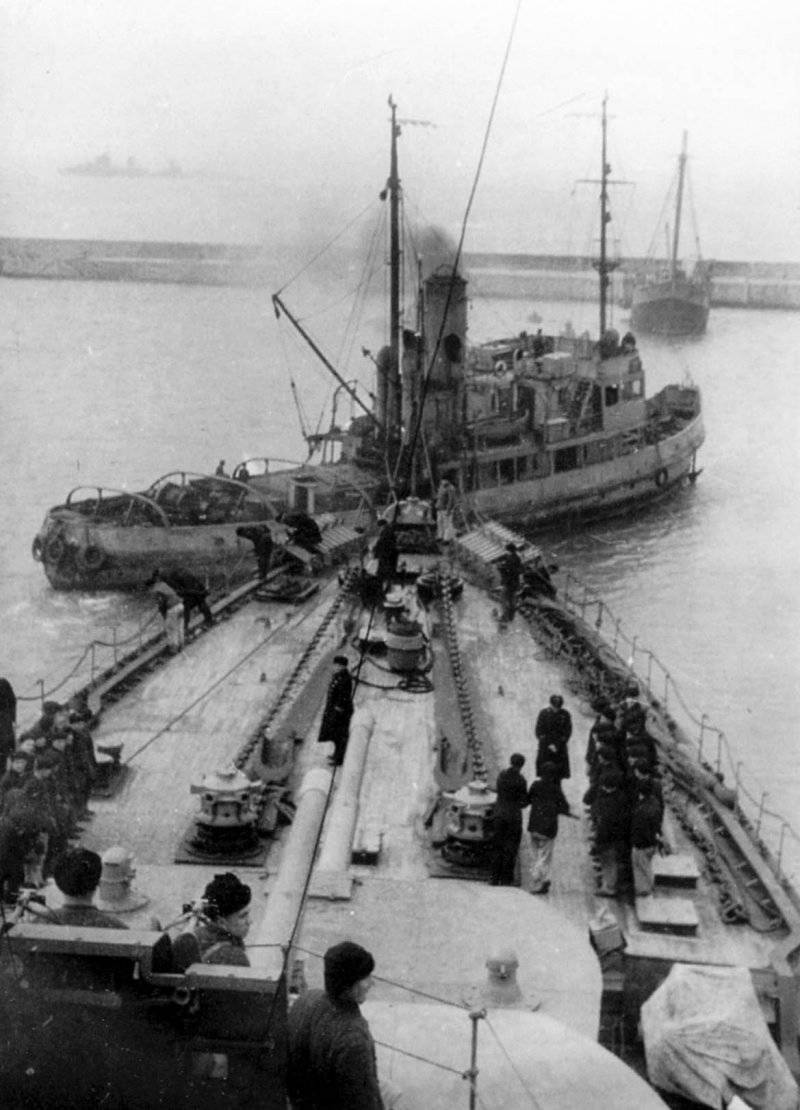
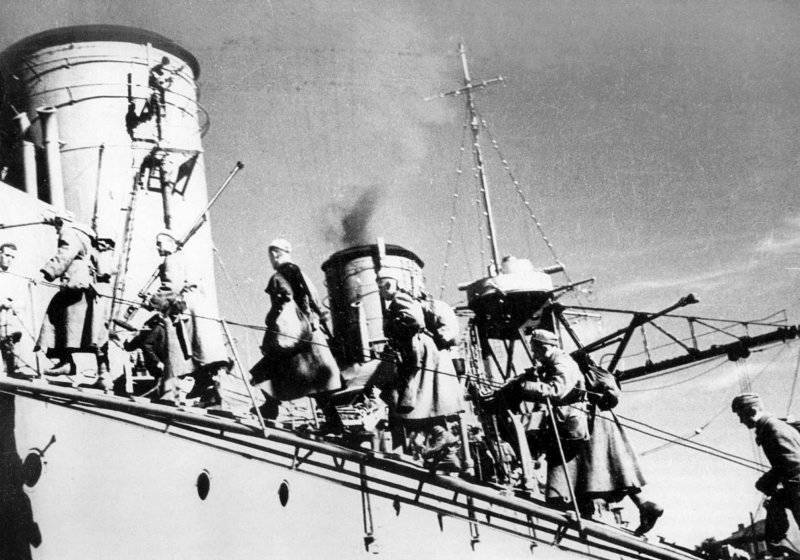
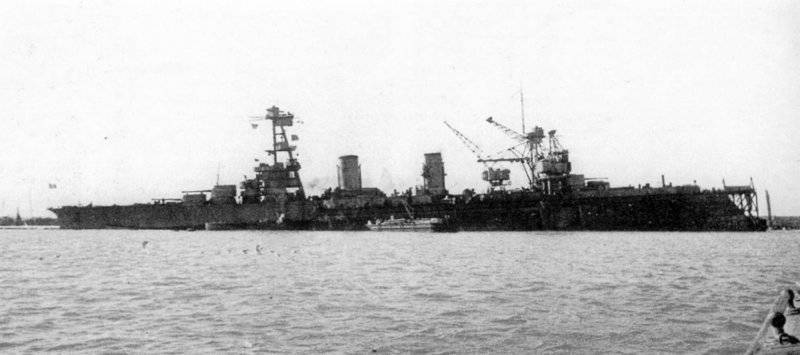
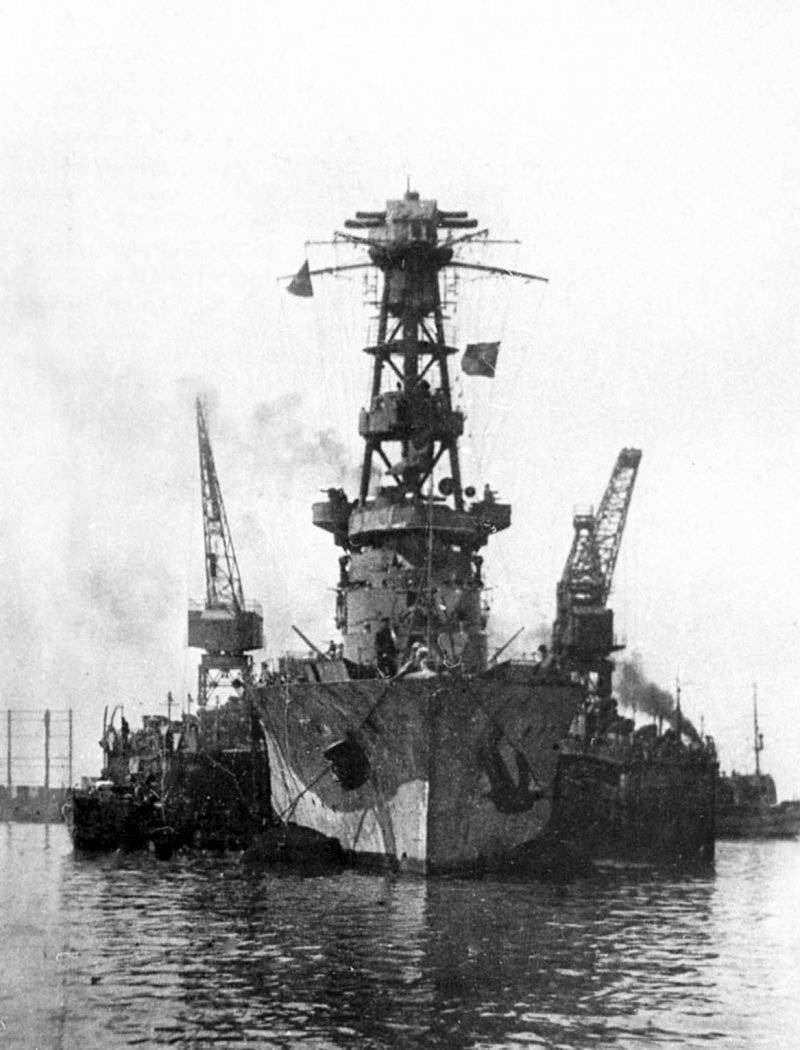
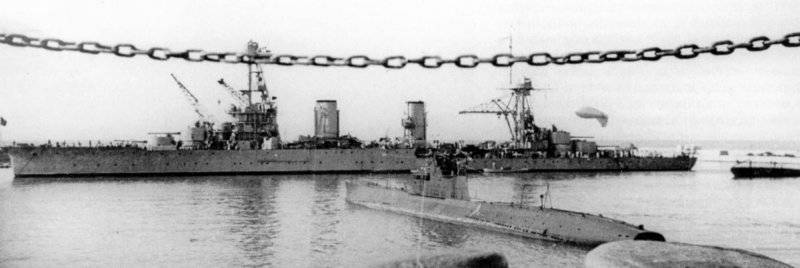
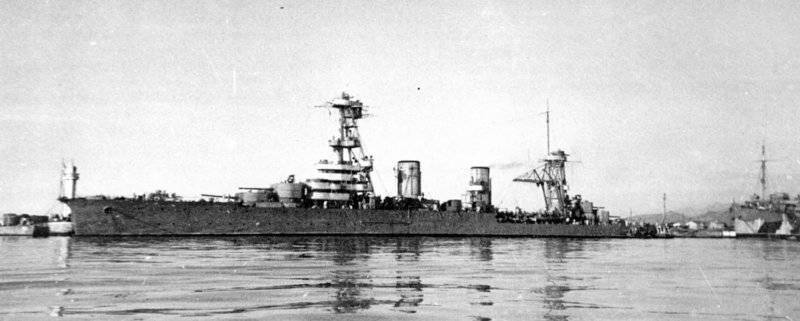
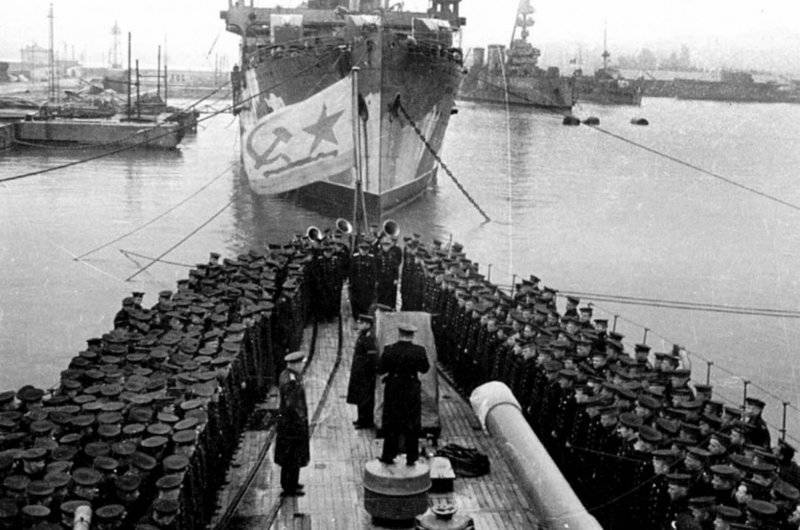
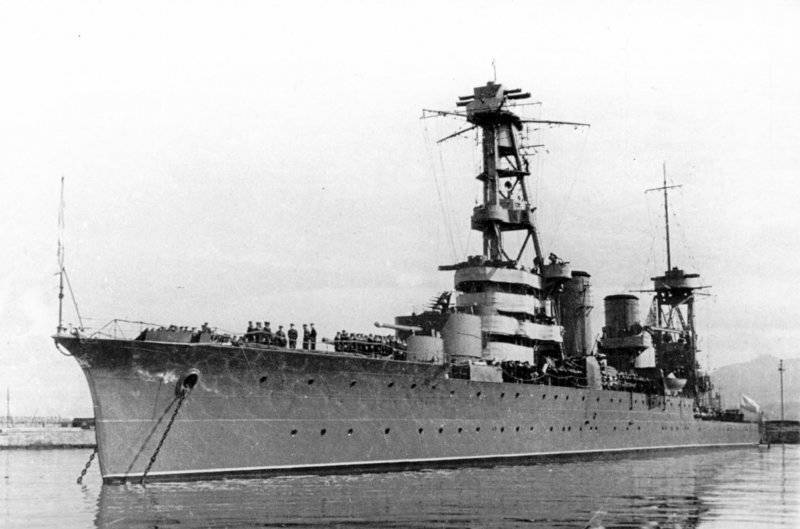
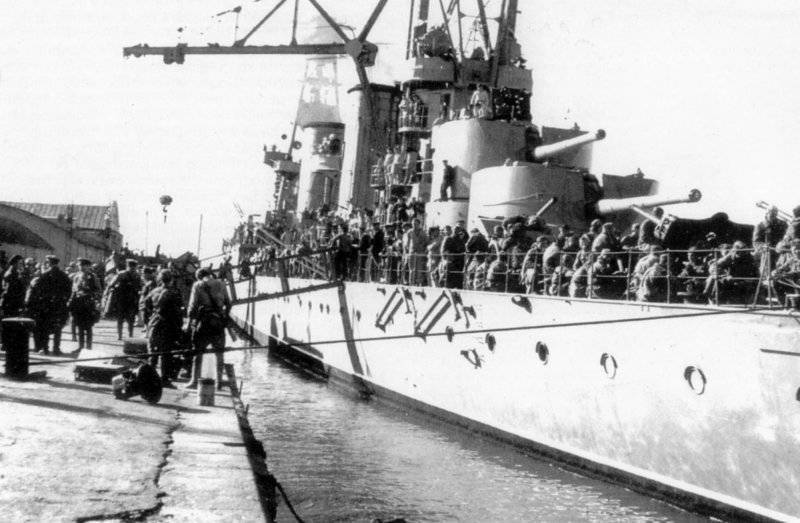
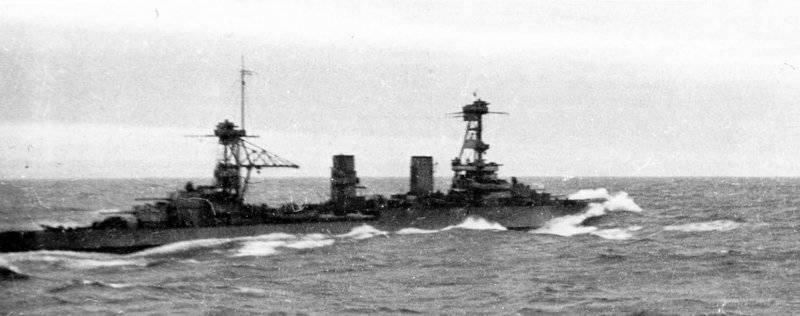

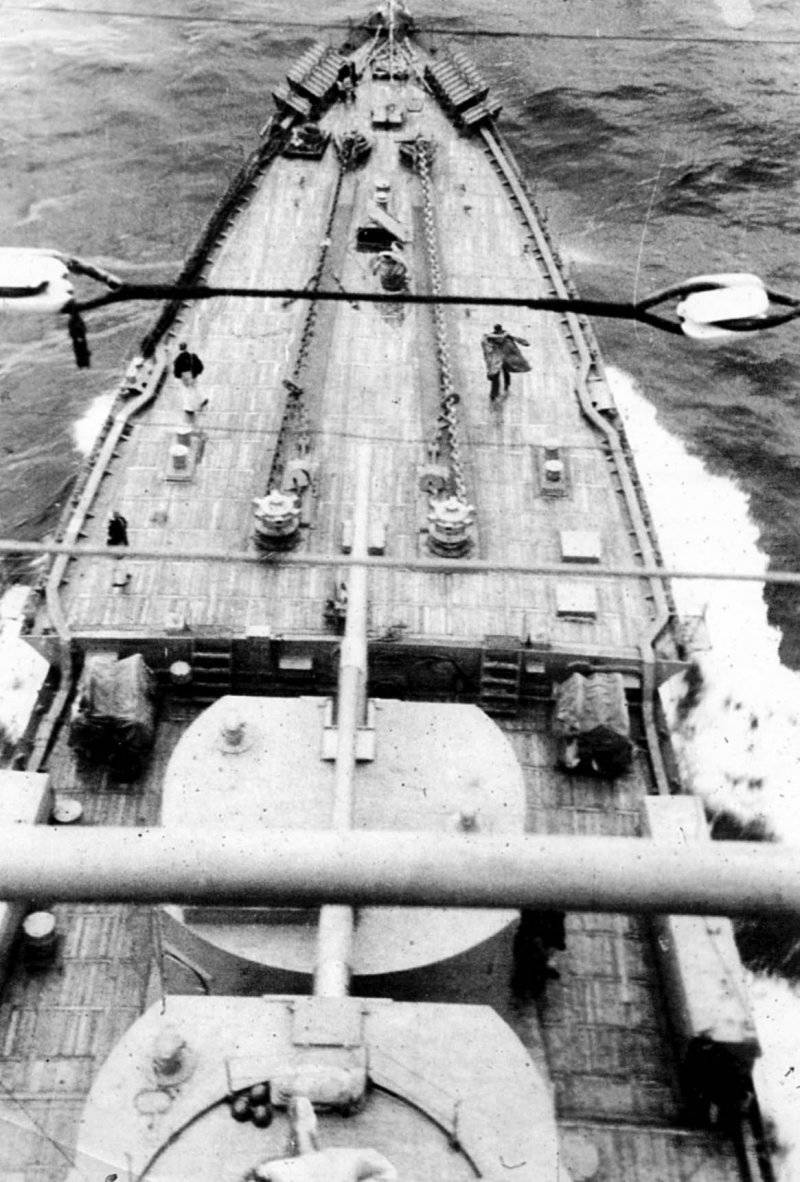
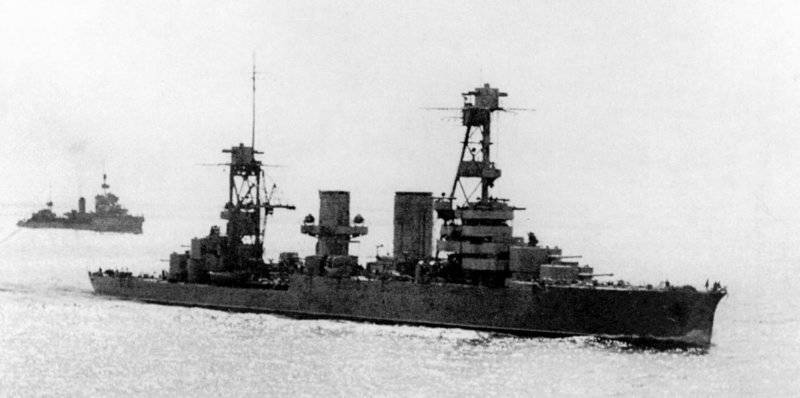
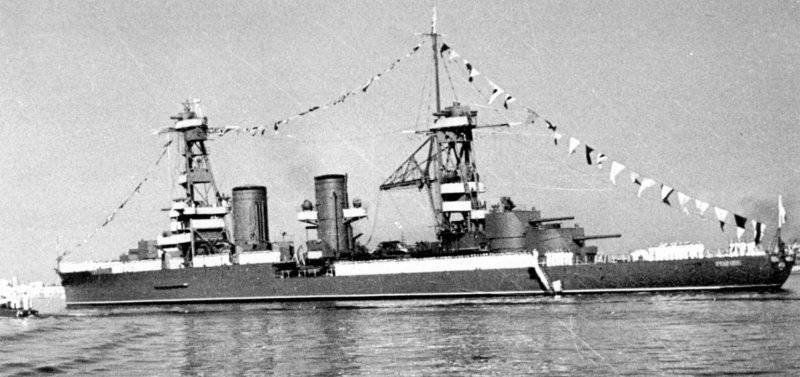
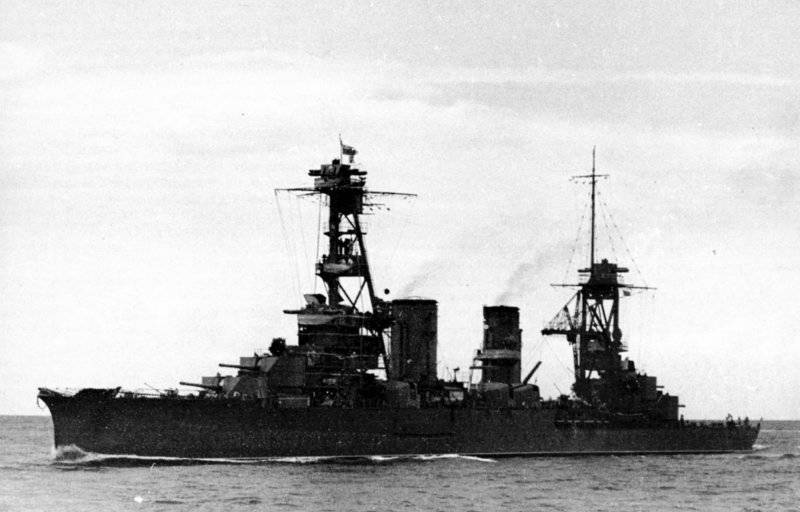
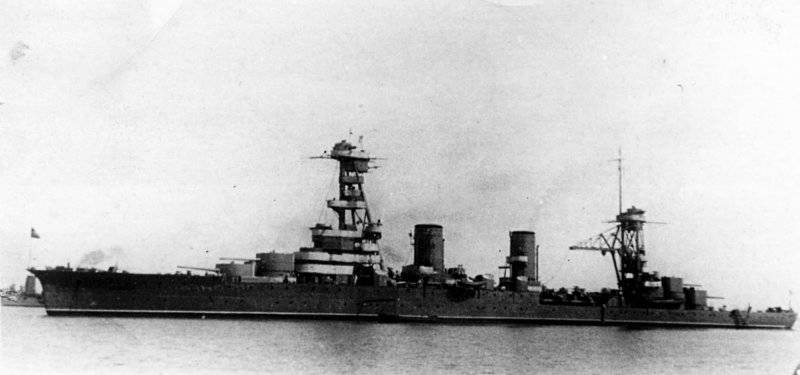
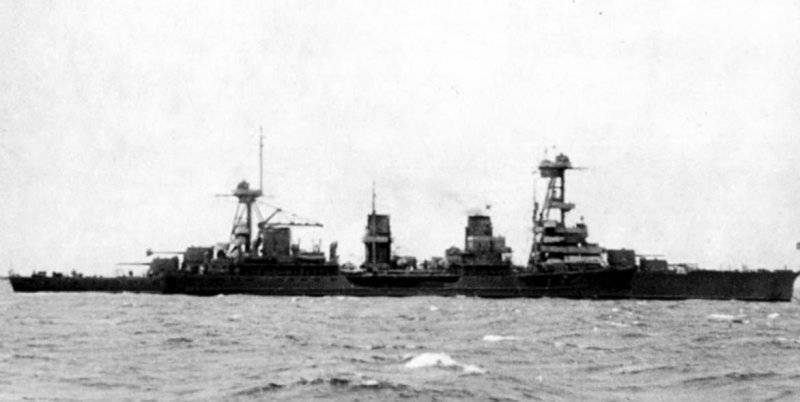
Information